#and the reference for tom is from the LA revival musical because I love the adorable little coveralls they put mary in <3< /div>
Explore tagged Tumblr posts
Text

I saw one of the SFTHtober prompts was the boys as fictional characters, watched Reefer Madness again and got possessed
Original Reference Images :)
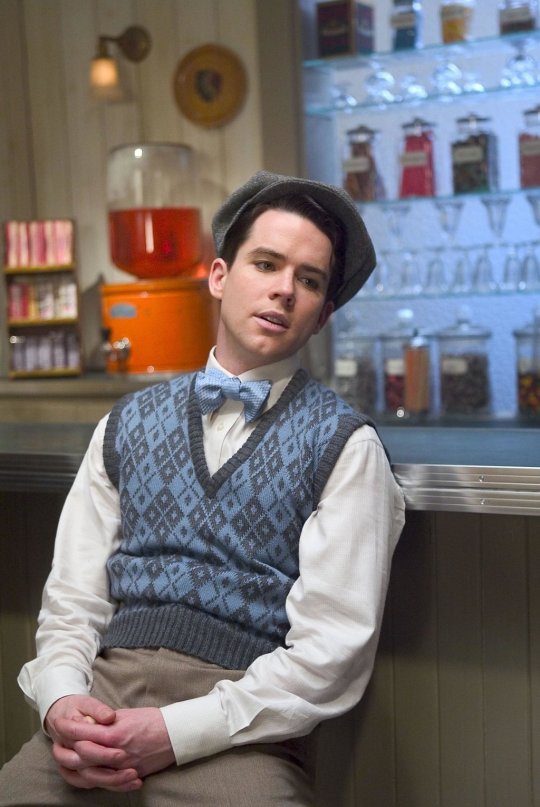


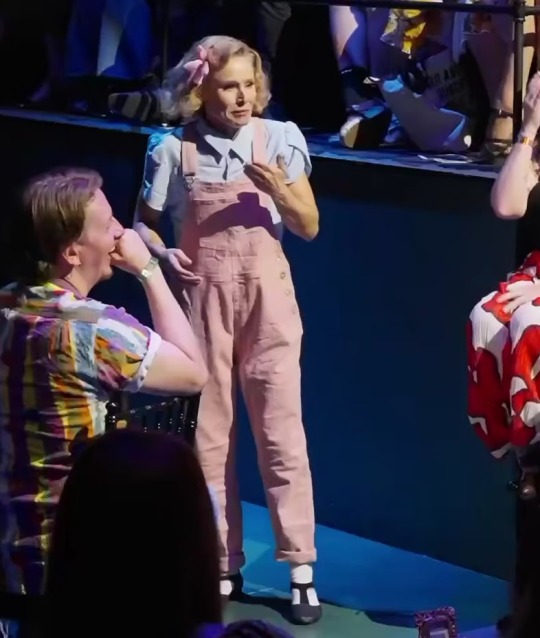
#shoot from the hip#shootimpro#sfth luke#sfth tom#sfth sam#sfth aj#sfth fanart#this was mostly an excuse to try new brushes#also if you havent seen reefer madness (2005) i highly recommend it#it's satire of a real PSA that feels like a sfth longform got turned into a feature length musical#be warned it is rated R so. be responsible!#characters go: tom - mary / sam - ralph / luke - jimmy / aj - mae#i have Reasons for my choices lol#and the reference for tom is from the LA revival musical because I love the adorable little coveralls they put mary in <3#uhh mh mutuals sorry for the british improv group posting ^^;
27 notes
·
View notes
Photo

Reality Shifting, or How To Travel the Omniverse in Five Easy TikTok Videos!
If you’ve been anywhere on the internet recently, you’ve likely heard about “Draco Malfoy TikTok”. It’s exploded in recent weeks — at time of writing, the hashtag #dracomalfoy currently boasts over 2 billion views. There’s a mix of videos and trends to be found within the #dracomalfoy tag: wholesome fan edits of clips from the Harry Potter films, PoV imaginings of what life would be like as Malfoy’s girlfriend, and general musings about just how unbearably hot he is.
In among these videos of Tom Felton being extremely, extremely fit, it’s not uncommon to stumble across a video explaining how you can literally be with Malfoy, through a process called reality shifting or just “shifting”. “Shifting is moving your consciousness from one reality to another reality,” this video explains. “You can train yourself to shift into an entirely different reality, such as Hogwarts.” There are shifting communities on apps like Amino and sites like Reddit, but it seems TikTok is home to the largest online shifting community.
The app’s hashtag #shiftingrealities has over 26.1 million views. While there are some videos from other fandoms, the overwhelming majority of these shifting videos are from Draco stans explaining how you can mentally transport yourself to Hogwarts. Interested? Of course you are. Well, there are two popular ways of doing this: “the raven method” involves lying down in a starfish position and counting down from 100 while imagining your desired reality, while the “the Alice in Wonderland method” requires the “shifter” to visualise themselves running after a person from their desired reality (for instance, Draco) and jumping down a rabbit hole with them. It sounds similar to lucid dreaming, but most members of the shifting community would argue that it’s far more intense and realistic than any dream.
Helen, 15, is a member of the ‘shifting community’ from Ireland. “I saw a lot of stuff on TikTok about shifting around a month ago and that was the first I’ve heard of it. I became very interested in it. I was confused at the idea of it at first, but I have a deeper understanding of it now that I’ve shifted myself,” she explains.
“Shifting is a very strange experience. It’s like an extremely vivid dream, yet it’s more real than any dream I’ve ever had. Before I plan on shifting I write myself a script in the notes app on my phone, in which I plan exactly what happens in the desired reality. This makes it easier to visualise exactly what I want to happen - so I might script that I want to go to Hogwarts and for Draco to be my boyfriend, or that he will flirt with me.”
LA-based Allison, 18, is another TikToker who’s dabbled in shifting. “I first got into Harry Potter in elementary school. My grandma loved the books and she would read them to us before bed — I always identified with the Slytherin house and had a crush on Draco,” she recalls. “Recently TikTok has reopened my love for the series.”
“Shifting is just something I found fascinating and I thought I’d try it out,” she explains. “The shifting experience is different for everyone. I see bright white lights flickering and my body begins to vibrate and go sort of numb. My legs will twitch and I’ll start to feel my thoughts get ‘lighter’. I’ll also hear people from my DR [desired reality] speaking - usually Draco.”
So what’s the science behind the strange phenomenon? Grace Warwick is a therapist with expertise in anomalous experiences. She says that this isn’t lucid dreaming, but is instead something called a “transliminal experience”. “Transliminal experiences occur when awake and are most common when the mind is in a soothed state - for example, upon waking and before falling asleep,” she explains. “The ‘instructions’ [for shifting] that abound on social media include being half asleep as a start point. They then introduce repetitive music [or] counting backwards slowly. All these factors would induce a state conducive to a transliminal experience. An interesting aspect of the techniques is the central part that a prepared ‘script’ plays - I would liken the role of the script to creating a guided meditation or working with active imagination.”
15-year-old Mavi lives in Florida and is another active member of both the shifting and Draco communities, boasting an impressive 149,000 followers on TikTok. Unlike Helen and Allison, she’s been into shifting for a long time. “Ever since I was little I have used daydreaming and lucid dreaming as an escape from my reality. About one year ago I came across shifting and I immediately felt drawn to it,” she explains. “Shifting feels like real life. I have only shifted to Hogwarts once [but] it was amazing. I made so many amazing friendships with the trio, Draco, Luna… it was the best time.”
Mavi says that she considers shifting a “hobby” - it’s clear she has a lot of varied interests, and shifting isn’t something which dominates or interferes with her day-to-day life. “I don’t wish I was in my DR full-time because I have so many things to live for in my CR [current reality], like acting and modelling.”
Evidently, Helen, Allison, and Mavi are all happy and healthy individuals, but Warwick says that these experiences can be different for different individuals. “For the vast majority, the current trend is simply the next iteration of our relationship to altered states — enjoyable and seemingly magical — but I would urge a sense of caution,” she says. “Key indicators to seek mental health support would be if the ‘shifter’ experienced anything that created fear for them, or challenged their belief system regarding what we could refer to as ‘consensual reality’. Also seek help if there is any ongoing drifting into altered states outside of intended ‘shifting’ sessions.”
Thankfully, as Warwick points out, “the vast majority” of shifters have a good experience: she says shifters can return to their current reality “[feeling] revived and energised by an experience that fitted with their belief system and experiential limits”. It’s also clear that both the Draco and shifting communities foster a healthy online space. “[The community] is actually a really nice environment and a great place to talk and express your common interests with people,” Helen says. Allison thinks “it’s definitely one of the kindest areas of TikTok”. And honestly, given the shitshow that 2020 has been, I think a (largely) wholesome community of young women who are all simultaneously Draco Malfoy’s girlfriend is the last thing anyone should be concerned about right now.
Source: i-D
(image via YouTube)
6 notes
·
View notes
Text
French Musicals Tag.
It is hard for me to give only one answer to each question, so I decided I was going to pick 1 to 3 answers. The musicals I took into consideration were: Roméo et Juliette, Notre Dame de Paris, Mozart l’Opéra Rock, 1789 - Les Amants de la Bastille and Le Roi Soleil. I tried to mix it up a little bit, so that I didn’t end up choosing the same musical all the time.
1. Favourite Musical: Roméo et Juliette, Notre Dame de Paris. I love both of these comédies musicales a lot. NDDP was the first one I ever saw, and it has a special place in my heart. Roméo et Juliette is the one I think about the most, and always want to rewatch.
2. Favourite Troupe: Roméo et Juliette (2001). I could have chosen NDDP for this as well, but I just adore the cast in the original ReTJ.
3. Favourite Male Singer: Tom Ross (RetJ), Damien Sargue (ReTJ), Bruno Pelletier (NDDP). I stopped at three because I promised I would, but there are many many talented male singers in these musicals.
4. Favourite Female Singer: Cécilia Cara (ReTJ), Victoria Petrosillo (Le Roi Soleil). Once again, it’s hard to just pick two!
5. Favourite Actor: Mikelangelo Loconte, Yamin Dib (Mozart l’Opéra Rock) Rosenberg is really funny, and I love the way Mikelangelo plays Mozart, so here it goes.
6. Favourite Actress: Réjane Perry (ReTJ). Amazing singer as well, I was sad to find out that she passed away in 2003.
7. Favourite Male Character: Tybalt (ReTJ). I mean, does it even need saying? I was thinking of putting somebody else here and him for favourite villain, but he is indeed my favourite character, so it makes much more sense to put him here, where he belongs.
8. Favourite Female Character: Juliette Capulet (ReTJ), Isabelle (Le Roi Soleil)
9. Favourite Understudy/Alternate: Diane Dassigny (MOR). I saw her in MOR 3D and to be honest liked her more than Claire Pérot.
10. Favourite Villain: Frollo (NDDP). I love Daniel Lavoie, and Frollo’s songs are just beautiful.
11. Favourite Song: this is impossibile, I am going to say Lune (NDDP), Le Duel, J’ai Peur (ReTJ), they are among my favourite in my two favourite musicals. (I briefly talked about my favourite songs from these musicals here and here)
12. Favourite Love Song: Un Jour, L’Amour Heureux (ReTJ). I mean, how could have I not chosen ReTJ for the love song?
13. Favourite Guilty Pleasure Song: I don’t consider any of them guilty pleasure songs, really? I’d say Les Solos Sous Les Draps, maybe (MOR). It’s sort of fun and silly and the title is a sexual reference so I guess it fits the category. Or maybe A’ quoi tu danses (1789), for dancing Robespierre.
14. Favourite Dance Sequence / Number: Le Bal (ReTJ 2001). I think it’s beautiful, I love the choreography and the colours, and I could rewatch it an inordinate amount of times to see what all the characters are up to.
15. Favourite Opening Number: super hard because the opening numbers are always amazing! I really enjoy all of them a lot. I think my favourite are Le Temps des Cathédrales (NDDP), Vérone (ReTJ)
16. Favourite Act 1 Finale: Aimer (ReTJ). This one wasn’t hard to answer!
17. Favourite Finale/Curtain Call: for the curtain call itself, Roméo et Juliette, because I love Benvolio presenting all the characters, and then Aimer/Les Rois du Monde (2001) and Les Rois du Monde/Avoir 20 ans (2010). For the final song, NDDP (Danse Mon Esmeralda) or MOR (Vivre à en crever).
18. Favourite Music Video: Ça ira mon amour (1789). I really liked Desmoulins as well. The official videos for the songs tend to be a bit weird in general.
19. Favourite Canon Pairing: Roméo et Juliette (ReTJ), Duc de Beaufort et Isabelle (Le Roi Soleil).
20. Favourite Non-Canon Pairing: probably Mozart and Salieri (MOR). I guess? I love seeing all the fanart.
21. Favourite Costume: I am doing it off the top of my head, because I would need to look at all the costumes of all the productions.
For male costumes, I love Tybalt’s costume in ReTJ 2001, both the red leather one and the one he is wearing at the ball (the trousers are the same). Also, the Duc de Beaufort’s black coat in Le Roi Soleil. And Mozart’s red coat in Je Dors sur des Roses.
For female costumes: Constance’s dress in Six Pieds Sous Terre and Nannerl’s dress in Penser l’Impossible (MOR).
22. Favourite Set Design: Roméo et Juliette 2001 (really, I think it’s sort of simple yet effective and I am not a big fan of the towers in the revival), 1789 - Les Amants de la Bastille, which was quite ingenious!
23. Favourite Choreography: That’s super difficult. I am ruling ReTJ out, because I chose Le Bal for the dance scene. The first musical to come to mind was Le Roi Soleil, because of its beautiful coreographies, and 1789 has great choreos, too. The thing is, when I have to think about a single choreography, my mind goes to Le Bien Qui Fait Mal (MOR). It’s probably not even my favourite, but it sure stays in your memory!
24. Favourite Foreign production: I have only seen Italian NDDP and Italian and Hungarian ReTJ (plus I listened to English ReTJ), so my choice is Italian Notre Dame de Paris! I think it’s a very good production.
25. An Underrated Musical: well, NDDP is super popular with the public all over the world. I think it’s the most popular French musical ever probably, and definitely the most popular out of the 5 I’ve chosen, but I have to say I don’t see many posts on Tumblr (maybe I am just using the wrong tags). Also, everytime I try to look it up in the tags I see tons of posts about the Hunchback of Notre Dame musical. People, if you loved Hunchback you need to watch NDDP.
26. An Underrated Pairing: maybe Mozart and Constance (MOR). I find posts about him and Salieri much more often (understandably, but still)
27. An Underrated Character: I am not sure she is underrated, but I am going for Fleur-de-Lys (NDDP).
28. An Underrated Song: oh, I am not sure I know which ones are underrated. Maybe Tu Dois Te Marier, 2001 version (ReTJ). I love that it’s so upbeat.
29. Fancast one musical: I can’t possibly think of doing this one, it would require too much thinking!
30. Free Choice. Okay, my free choice is: most random thing you love about a musical. And for me it is the way Mercutio is pronounced in French, I LOVE IT.
23 notes
·
View notes
Text
For Millions of Americans TikTok Is Offering a Wild Uncut Introduction to 80s-Style Flair Bartending

Wearing a flowered top, her long blonde hair cascading over her shoulders, Shay Court juggles a pink shaker tin while tossing a bottle of Tito’s behind her back, all in motions so fast it’s hard to keep up. In the 15-second video, Bruno Mars’ “Uptown Funk” plays and, when the diminutive crooner yells “Stop!,” Court immediately halts her bottle-tossing perfectly on the beat (“Wait a minute…”), the Tito’s held upside down near her head, enabling her to long-pour the vodka into a pint glass below.
“Drinks during quarantine be like…?,” writes Court, better known as the @flairbartendress to her 27,000 followers on TikTok.
While Instagram is rife with very serious amateur bartenders doing very serious things, TikTok is where all the fun is going on these days — mostly in the form of flair bartending, a much-maligned art form you probably haven’t thought about in a while. In fact, the majority of the most followed #cocktail and #bartending accounts on TikTok are for flair bartenders. The #flairbartending hashtag itself has a stunning 36 million views.
@flairbartendressDrinks during quarantine be like.. ? ##flairbartending ##fyp ##foryou ##new ##bartender ##flair ##drinks♬ Stop! Wait a Minute – Bruno Mars, Tik Tok
It all kind of makes sense — flipping bottles behind your back and juggling shakers in the air is a perfect fit for TikTok’s short-form video platform typically employed by teenagers for improvised dances and lip-sync videos. (Isn’t flair bartending just dancing with bottles?) With most all flair bartenders out of work these days, they’ve gravitated to this hippest and youngest of social media platforms.
Court says she got introduced to TikTok by her 8-year-old daughter. A Canadian, she learned her craft working in Las Vegas bars like Bally’s and Kahunaville. Today, Court is a private events bartender in northern Kentucky, but with few private events at the moment, she began fooling around on TikTok. There were already some flair bartenders on TikTok doing their thing, but Court thought she could really lean into the platform’s full capabilities.
“I wanted to do — not just flair — but thought maybe I could take those TikTok trends and put my own spin on them,” she explains. In TikTok parlance, Court is referring to the site’s most viral sounds of the moment, usually snippets from songs but sometimes mere audio clips, often bolstered by a hashtag like, say, #savage. That’s why if you venture into the wild world of TikTok, you’ll notice many kids doing similar dance moves all to the exact same clip from the exact same song. Like Court, who took viral audio from the bbno$ rap “Nursery,” which many TikTokers had been syncing to funny videos of themselves going from stumbling to strutting, and instead matched it to her flair. That TikTik alone has racked up 1.2 million views so far. “That’s not something a lot of people have seen with flair bartending,” she says.
If flair bartending emerged across America in the 1980s, reaching its pinnacle in the 1988 Tom Cruise movie “Cocktail,” nowadays, it mainly exists in competition form, often in Eastern Europe, with very few American localities having much of a flair community. And, during a pandemic, if “normal” bars are able to offer takeaway cocktails and sidewalk and patio service, you’re not exactly going to see someone flipping bottles on Fifth Avenue. That’s why most of these furloughed flair masters are left performing tricks from their kitchens, backyards, and living rooms.
“The videos must be more impressive because the [bar] scene is not there,” says John Faller (@cocktailsgarnishes) who is stuck doing flair tricks on a rug in front of his TV or in the foyer by an umbrella rack for his 60,000 followers. “It brings more challenges and pushes the limits of imagination away,” he adds.
@cocktailsgarnishes##chaussettes ##costume ##flip ##jonglage ##somelier ##viral ##style ##barman ##bartender ##cocktails ##wine ##foryou ##pourtoi♬ PYRO – Chester Young & Castion
The Frenchman works at an upscale hotel bar in non-pandemic times and he’s been incorporating flair into his professional bartending for nearly a decade. He started using Instagram in early 2019, mostly to post his beautiful and baroque garnishes. They were getting some attention, but not a ton. After noticing that TikTok was booming, he pivoted to posting flair videos there in late February of this year. He now has 10 times the followers on TikTok compared to Instagram, despite posting nearly the exact same videos. Other flair bartenders have noticed the same thing.
There’s three-time world flair champion Luca Valentin, who doesn’t just juggle bottles but three separate accounts on TikTok, most notably for flair purposes @valentinluca and @cocktailswithluca. The Romanian man started posting to the latter in mid-May, building an Ecuador cocktail by flipping a wine glass and his bottles of rum in the air, tossing some lemon juice behind his back, flipping ice from a shovel into the glass, and flicking the cap off a tonic bottle. In the two months since, he’s made over 40 more videos, quickly amassing 85,000 followers and over half a million likes. (He has less than half the amount of followers on his Instagram page, which he has been using for over seven years.)
The thing is, many of these young TikToker users — some 69 percent, are between ages 13 and 24; almost none are older than 40 — have surely never seen a flair bartender in person so they have no preconceived notions. Hell, many high school- and college-aged TikTokers have perhaps never legally even been inside a bar. So flair bartending in any form is an exotic new world to them. Which makes me wonder if TikTok could be completely reviving this often-ignored niche of mixology.
“I think with the younger kids, they get excited when they see it — it’s a show for them,” says Zach Prohaska, who posts as @cdbartending. He finds the same is true in the real world, quite frankly; he works plenty of bar mitzvahs where the tweens are wowed when he teaches them tricks with a soda can.
@cdbartendingA Blue Lagoon ?⛱? ##bartender ##blue ##fyp ##cocktail ##learnfromme ##learnfromhome ##SummerProject ##foryou♬ Jus’ Know – BlackMayo
“Yes, I do have followers that are underage,” admits Kevin Gibbons. As his @elitebartendingfl is a “pro” TikTok account, he can monitor his viewership analytics more closely. “They say, ‘You’ve made me want to be a bartender when I’m older’ — and that’s kind of what I want!”
Gibbons, an Englishman, currently lives in Orlando and owns and runs several Elite Bartending schools, all of which are associated with actual bars like The Attic. When those bars were forced to close due to the pandemic, and he could no longer teach his students in person, he took four pieces of wood, spent 20 minutes building a makeshift bar in front of his home, and began demonstrating flair tricks and cocktail making on TikTok. Next thing he knew he had over 300,000 followers and 4 million likes (compared to just 15,000 followers on his Instagram).
“I wasn’t really prepared for that—I certainly didn’t start out to become an influencer,” he jokes. He’s now getting sent products, merchandise, and sponsorship opportunities.
Unlike Court, Faller, and Valentin, Gibbons’ TikTok flair is less based on the music-backed, “how-did-he-do- that?!” razzle dazzle and is instead more of a tutorial. I particularly enjoyed one TikTok where he teaches you to juggle bottles by envisioning an upside-down triangle above your head. Gibbons claims this method has taught people flair juggling in as quick as two minutes.
“With TikTok, it’s so visually pleasing to the eye — you’re getting cocktails and a show,” says Gibbons. But he doesn’t think it’s pure frivolity and, in fact, preaches to his students (and viewers) that it can help them increase their nightly tips. “I’ve always felt like it gives the image of a bartender being next-level.”
Prohaska, for one, agrees. He also runs a bartending school and events companies in Toronto. He joined TikTok late last year after seeing a Gary Vaynerchuk video explaining how it’s now the fastest growing social media platform. Though Prohaska claims he was immediately overwhelmed by the rapid-fire, fresh-faced platform — “I’ll be honest, I felt like I was 100 years old” — he nevertheless started posting some videos and immediately began getting exposure, especially for his garnish and knife tricks (and, yes, blue cocktails).
“Let’s be honest: Flair is a pretty cool thing. And it’s new to this younger crowd,” says Prohaska, who has been bartending for 20 years and incorporating flair for 16. Like Gibbons, he, too, believes in more practical flair; not wasting 20 minutes tossing bottles around, but instead using each movement to work toward getting a drink ultimately made.
“I get it. I used to hate flair, too,” he’s quick to add. “Now I hate how everyone will talk smack about flair, but I understand — I was that bartender. Once you learn it effectively, though, the people you’re serving love to see it.”
As Prohaska alludes to, the cocktail cognoscenti have always maligned flair, thinking it cheesy and an impediment to serious drinks-making. If it appears in pop culture nowadays, it’s mostly to show the hubris of a non-bartender put under the limelight, like, say, “King of Queens”’ oafish Kevin James dropping bottles upon trying a trick beyond his skill level. So, if flair bartending has mostly been a punchline for the last two decades, these TikTokers seem to be bringing back it’s, uh, respectability.
“I’ve never been this viral,” says Court, who amazingly has garnered her following with a mere 20 TikToks posted so far. “And it’s a lot of people that I’ve never met who suddenly have an interest in flair. Ninety-nine percent of the comments are positive. ‘Oh, that’s really cool, I’d like to try that.’”
I’ve wondered if there are people on TikTok now trying out flair tricks who have nothing to do with the bartending industry. The answer would seem to be yes. In fact, The Rock recently reposted one of Prohaska’s videos to his 190 million followers; Prohaska quickly added 45,000 new followers that night alone. But it’s not just celebrities, of course, who are into TikTok flair. It’s mostly regular users.
“I get ‘dueted’ everyday,” says Gibbons referring to TikTok’s method of allowing users to create side-by-side videos with people they follow, trying to synchronize their moves to the person they dueted. These duets are mostly being created by flair neophytes, young TikTokers seeing this crazy form of bartending as simply another meme, another viral dance move to put their own spin on. It’s really not a surprise to me — these TikTok users are the same generation that made water bottle flipping a thing in the summer of 2016.
Court thinks this newfound attention to flair might not just be because of the pandemic, but thanks to it, as flair bartenders are no longer working in their bars. She thinks there’s a certain charm to her doing tricks in regular clothes, in her living room or backyard; the casual setting is more likely to inspire her followers to try it out themselves.
“It allows the everyday person to relate because I’m not in a totally professional setting,” she says. “‘Wow, look what you can do!’”
But, just like most people don’t watch TikTok dance videos because they want to learn to The Renegade, most people don’t seem to watch these flair bartending videos because they want to start juggling bottles of Tito’s and working on four-foot-long pours. As Prohaska says: “A lot of my followers just miss the social part of the bar scene. They leave me comments: ‘I miss going to bars. But if the bars were open, I’d be at yours!’”
The article For Millions of Americans, TikTok Is Offering a Wild, Uncut Introduction to ’80s-Style Flair Bartending appeared first on VinePair.
Via https://vinepair.com/articles/tiktok-flair-bartending/
source https://vinology1.weebly.com/blog/for-millions-of-americans-tiktok-is-offering-a-wild-uncut-introduction-to-80s-style-flair-bartending
0 notes
Text
For Millions of Americans, TikTok Is Offering a Wild, Uncut Introduction to ’80s-Style Flair Bartending
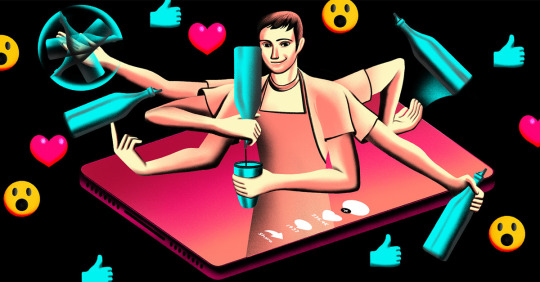
Wearing a flowered top, her long blonde hair cascading over her shoulders, Shay Court juggles a pink shaker tin while tossing a bottle of Tito’s behind her back, all in motions so fast it’s hard to keep up. In the 15-second video, Bruno Mars’ “Uptown Funk” plays and, when the diminutive crooner yells “Stop!,” Court immediately halts her bottle-tossing perfectly on the beat (“Wait a minute…”), the Tito’s held upside down near her head, enabling her to long-pour the vodka into a pint glass below.
“Drinks during quarantine be like…🤪,” writes Court, better known as the @flairbartendress to her 27,000 followers on TikTok.
While Instagram is rife with very serious amateur bartenders doing very serious things, TikTok is where all the fun is going on these days — mostly in the form of flair bartending, a much-maligned art form you probably haven’t thought about in a while. In fact, the majority of the most followed #cocktail and #bartending accounts on TikTok are for flair bartenders. The #flairbartending hashtag itself has a stunning 36 million views.
@flairbartendressDrinks during quarantine be like.. 🤪 ##flairbartending ##fyp ##foryou ##new ##bartender ##flair ##drinks♬ Stop! Wait a Minute – Bruno Mars, Tik Tok
It all kind of makes sense — flipping bottles behind your back and juggling shakers in the air is a perfect fit for TikTok’s short-form video platform typically employed by teenagers for improvised dances and lip-sync videos. (Isn’t flair bartending just dancing with bottles?) With most all flair bartenders out of work these days, they’ve gravitated to this hippest and youngest of social media platforms.
Court says she got introduced to TikTok by her 8-year-old daughter. A Canadian, she learned her craft working in Las Vegas bars like Bally’s and Kahunaville. Today, Court is a private events bartender in northern Kentucky, but with few private events at the moment, she began fooling around on TikTok. There were already some flair bartenders on TikTok doing their thing, but Court thought she could really lean into the platform’s full capabilities.
“I wanted to do — not just flair — but thought maybe I could take those TikTok trends and put my own spin on them,” she explains. In TikTok parlance, Court is referring to the site’s most viral sounds of the moment, usually snippets from songs but sometimes mere audio clips, often bolstered by a hashtag like, say, #savage. That’s why if you venture into the wild world of TikTok, you’ll notice many kids doing similar dance moves all to the exact same clip from the exact same song. Like Court, who took viral audio from the bbno$ rap “Nursery,” which many TikTokers had been syncing to funny videos of themselves going from stumbling to strutting, and instead matched it to her flair. That TikTik alone has racked up 1.2 million views so far. “That’s not something a lot of people have seen with flair bartending,” she says.
If flair bartending emerged across America in the 1980s, reaching its pinnacle in the 1988 Tom Cruise movie “Cocktail,” nowadays, it mainly exists in competition form, often in Eastern Europe, with very few American localities having much of a flair community. And, during a pandemic, if “normal” bars are able to offer takeaway cocktails and sidewalk and patio service, you’re not exactly going to see someone flipping bottles on Fifth Avenue. That’s why most of these furloughed flair masters are left performing tricks from their kitchens, backyards, and living rooms.
“The videos must be more impressive because the [bar] scene is not there,” says John Faller (@cocktailsgarnishes) who is stuck doing flair tricks on a rug in front of his TV or in the foyer by an umbrella rack for his 60,000 followers. “It brings more challenges and pushes the limits of imagination away,” he adds.
@cocktailsgarnishes##chaussettes ##costume ##flip ##jonglage ##somelier ##viral ##style ##barman ##bartender ##cocktails ##wine ##foryou ##pourtoi♬ PYRO – Chester Young & Castion
The Frenchman works at an upscale hotel bar in non-pandemic times and he’s been incorporating flair into his professional bartending for nearly a decade. He started using Instagram in early 2019, mostly to post his beautiful and baroque garnishes. They were getting some attention, but not a ton. After noticing that TikTok was booming, he pivoted to posting flair videos there in late February of this year. He now has 10 times the followers on TikTok compared to Instagram, despite posting nearly the exact same videos. Other flair bartenders have noticed the same thing.
There’s three-time world flair champion Luca Valentin, who doesn’t just juggle bottles but three separate accounts on TikTok, most notably for flair purposes @valentinluca and @cocktailswithluca. The Romanian man started posting to the latter in mid-May, building an Ecuador cocktail by flipping a wine glass and his bottles of rum in the air, tossing some lemon juice behind his back, flipping ice from a shovel into the glass, and flicking the cap off a tonic bottle. In the two months since, he’s made over 40 more videos, quickly amassing 85,000 followers and over half a million likes. (He has less than half the amount of followers on his Instagram page, which he has been using for over seven years.)
The thing is, many of these young TikToker users — some 69 percent, are between ages 13 and 24; almost none are older than 40 — have surely never seen a flair bartender in person so they have no preconceived notions. Hell, many high school- and college-aged TikTokers have perhaps never legally even been inside a bar. So flair bartending in any form is an exotic new world to them. Which makes me wonder if TikTok could be completely reviving this often-ignored niche of mixology.
“I think with the younger kids, they get excited when they see it — it’s a show for them,” says Zach Prohaska, who posts as @cdbartending. He finds the same is true in the real world, quite frankly; he works plenty of bar mitzvahs where the tweens are wowed when he teaches them tricks with a soda can.
@cdbartendingA Blue Lagoon 🌊⛱🍹 ##bartender ##blue ##fyp ##cocktail ##learnfromme ##learnfromhome ##SummerProject ##foryou♬ Jus’ Know – BlackMayo
“Yes, I do have followers that are underage,” admits Kevin Gibbons. As his @elitebartendingfl is a “pro” TikTok account, he can monitor his viewership analytics more closely. “They say, ‘You’ve made me want to be a bartender when I’m older’ — and that’s kind of what I want!”
Gibbons, an Englishman, currently lives in Orlando and owns and runs several Elite Bartending schools, all of which are associated with actual bars like The Attic. When those bars were forced to close due to the pandemic, and he could no longer teach his students in person, he took four pieces of wood, spent 20 minutes building a makeshift bar in front of his home, and began demonstrating flair tricks and cocktail making on TikTok. Next thing he knew he had over 300,000 followers and 4 million likes (compared to just 15,000 followers on his Instagram).
“I wasn’t really prepared for that—I certainly didn’t start out to become an influencer,” he jokes. He’s now getting sent products, merchandise, and sponsorship opportunities.
Unlike Court, Faller, and Valentin, Gibbons’ TikTok flair is less based on the music-backed, “how-did-he-do- that?!” razzle dazzle and is instead more of a tutorial. I particularly enjoyed one TikTok where he teaches you to juggle bottles by envisioning an upside-down triangle above your head. Gibbons claims this method has taught people flair juggling in as quick as two minutes.
“With TikTok, it’s so visually pleasing to the eye — you’re getting cocktails and a show,” says Gibbons. But he doesn’t think it’s pure frivolity and, in fact, preaches to his students (and viewers) that it can help them increase their nightly tips. “I’ve always felt like it gives the image of a bartender being next-level.”
Prohaska, for one, agrees. He also runs a bartending school and events companies in Toronto. He joined TikTok late last year after seeing a Gary Vaynerchuk video explaining how it’s now the fastest growing social media platform. Though Prohaska claims he was immediately overwhelmed by the rapid-fire, fresh-faced platform — “I’ll be honest, I felt like I was 100 years old” — he nevertheless started posting some videos and immediately began getting exposure, especially for his garnish and knife tricks (and, yes, blue cocktails).
“Let’s be honest: Flair is a pretty cool thing. And it’s new to this younger crowd,” says Prohaska, who has been bartending for 20 years and incorporating flair for 16. Like Gibbons, he, too, believes in more practical flair; not wasting 20 minutes tossing bottles around, but instead using each movement to work toward getting a drink ultimately made.
“I get it. I used to hate flair, too,” he’s quick to add. “Now I hate how everyone will talk smack about flair, but I understand — I was that bartender. Once you learn it effectively, though, the people you’re serving love to see it.”
As Prohaska alludes to, the cocktail cognoscenti have always maligned flair, thinking it cheesy and an impediment to serious drinks-making. If it appears in pop culture nowadays, it’s mostly to show the hubris of a non-bartender put under the limelight, like, say, “King of Queens”’ oafish Kevin James dropping bottles upon trying a trick beyond his skill level. So, if flair bartending has mostly been a punchline for the last two decades, these TikTokers seem to be bringing back it’s, uh, respectability.
“I’ve never been this viral,” says Court, who amazingly has garnered her following with a mere 20 TikToks posted so far. “And it’s a lot of people that I’ve never met who suddenly have an interest in flair. Ninety-nine percent of the comments are positive. ‘Oh, that’s really cool, I’d like to try that.’”
I’ve wondered if there are people on TikTok now trying out flair tricks who have nothing to do with the bartending industry. The answer would seem to be yes. In fact, The Rock recently reposted one of Prohaska’s videos to his 190 million followers; Prohaska quickly added 45,000 new followers that night alone. But it’s not just celebrities, of course, who are into TikTok flair. It’s mostly regular users.
“I get ‘dueted’ everyday,” says Gibbons referring to TikTok’s method of allowing users to create side-by-side videos with people they follow, trying to synchronize their moves to the person they dueted. These duets are mostly being created by flair neophytes, young TikTokers seeing this crazy form of bartending as simply another meme, another viral dance move to put their own spin on. It’s really not a surprise to me — these TikTok users are the same generation that made water bottle flipping a thing in the summer of 2016.
Court thinks this newfound attention to flair might not just be because of the pandemic, but thanks to it, as flair bartenders are no longer working in their bars. She thinks there’s a certain charm to her doing tricks in regular clothes, in her living room or backyard; the casual setting is more likely to inspire her followers to try it out themselves.
“It allows the everyday person to relate because I’m not in a totally professional setting,” she says. “‘Wow, look what you can do!’”
But, just like most people don’t watch TikTok dance videos because they want to learn to The Renegade, most people don’t seem to watch these flair bartending videos because they want to start juggling bottles of Tito’s and working on four-foot-long pours. As Prohaska says: “A lot of my followers just miss the social part of the bar scene. They leave me comments: ‘I miss going to bars. But if the bars were open, I’d be at yours!’”
The article For Millions of Americans, TikTok Is Offering a Wild, Uncut Introduction to ’80s-Style Flair Bartending appeared first on VinePair.
source https://vinepair.com/articles/tiktok-flair-bartending/ source https://vinology1.tumblr.com/post/626613969391632384
0 notes
Text
The Complete List of Lin-Manuel Miranda Projects
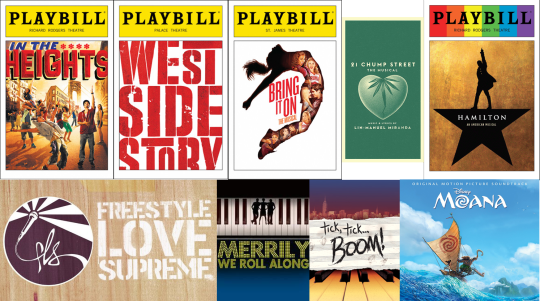
Where possible I have noted availability for purchase/viewing/listening. For future projects I’ve included as much detail as we have and I’ll keep updating the post when we have more. Cameos are listed separately at the end. If you think I’m missing anything, drop me a message/ask.
This is a very long post because Lin works a lot, so I have saved your dashes and put the content behind a read more. Let’s go.
Freestyle Love Supreme (2003-)
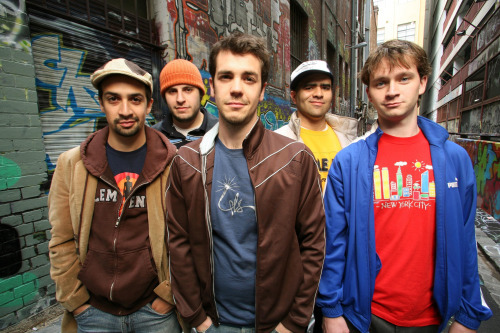
What is it? Freestyle Love Supreme is an improv hip-hop comedy troupe started by Lin, Anthony Veneziale and Tommy Kail. It has had a long life playing clubs and comedy festivals all around the world and spawned a TV show in 2014.
What did Lin do in it? Lin is one of the main MCs in the group.
How do I find it? For answers to all the FLS questions you’ve ever had, please see my incredibly comprehensive masterpost. The TV series is available for streaming if you have a Seeso subscription and can be purchased from iTunes/Amazon if you have US accounts.
In the Heights (2000, 2007, 2008, 2010)

What is it? In the Heights is a musical originally conceived, written and directed by Lin while a college sophomore. It was eventually developed into an Broadway show.
When was it on? Off-Broadway at the now defunct 37 Arts in 2007, on Broadway from 2008 to 2011. It had a US touring production from 2009 to 2011 and numerous authorized international productions since.
What did Lin do in it? He wrote the music and lyrics. He also starred as Usnavi in the entire off-Broadway production, the first year of the Broadway production and for the LA and Puerto Rico stops of the touring production.
How do I find it? You can purchase the cast album wherever you buy music. It is also available on Spotify. If you want to see a production, there are plenty of regional/local productions running in the US, including the first authorized all-Spanish version in DC. Here are some clips from the Broadway production.
In the Heights: Chasing Broadway Dreams (2008)
What is it? Chasing Broadway Dreams is a fantastic documentary by PBS on the making of In the Heights. Handily it also contains performance excerpts from the show.
How do I find it? Right here on Youtube.
Working (2008)
What is it? Working is a musical with a book by Nina Faso and Stephen Schwartz and music by a small group of composers that originally ran on Broadway in 1978. In the late 00s Schwartz put together a new version (known as the 2012 revised version), adding new songs and trimming characters.
When was it on? The new version has had a bunch of regional productions and is about to debut in the UK (as at May 2017).
What did Lin do in it? He contributed two new songs, Delivery and A Very Good Day. The first is about his own experiences as a McDonalds delivery boy, and the second about an immigrant nanny and an elderly care worker.
How do I find it? You can go here to see Lin talk about writing the songs and there are some videos floating around Youtube from regional/local productions. The London production produced a cast recording which includes Lin’s new songs.
The Brief Wondrous Life of Oscar Wao (with Karen Olivo) (2008)

What is it? A Pulitzer Prize-winning novel by Junot Diaz about a nerdy Dominican boy growing up in New Jersey
What did Lin do in it? He read the UK version of the audiobook with Karen Olivo.
How do I find it? Amazon, Audiobook.com and an excerpt here.
West Side Story (2009)
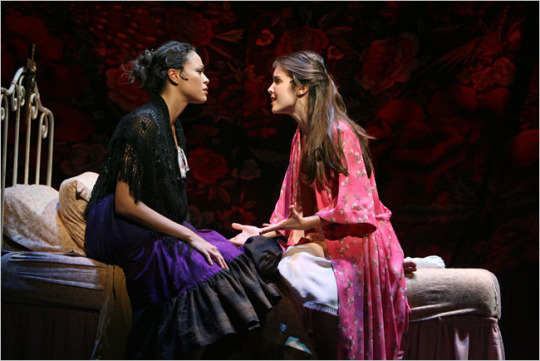
What is it? The classic 1957 musical by Arthur Laurents, Leonard Bernstein, Stephen Sondheim and Jerome Robbins, recently revived by the surviving members of the original creative team (Sondheim and Laurents).
When was it on? The most recent Broadway revival opened in 2009 and closed in 2011.
What did Lin do in it? Lin was hired by the creative team to translate the dialogue spoken and lyrics sung by the Puerto Rican characters into Spanish. This included translating iconic songs such as I Feel Pretty, Tonight and A Boy Like That.
How do I find it? There’s a cast recording which is available for purchase and on Spotify. Here’s a sizzle reel of performance clips.
Sesame Street (2009-2013)

What is it? You know.
What did Lin do in it? Lin made his first appearance as the villainous Freddy Flapman in season 40 and also voiced a lamb (Lamb-Manuel, ahem) and performed the theme song of the Murray Has A Little Lamb segment. He composed the music for 5 songs in seasons 42-45, including “Rhymes with Mando”, which was nominated for a Day Time Emmy.
How do I find it? Should you wish to explore this aspect of Lin’s career, here is the segment with Freddy Flapman. Here is Lin as Lamb-Manuel. Here is the Emmy-nominated Rhymes With Mando and here’s a very familiar voice singing the Murray Has A Little Lamb theme.
The Electric Company (2009-2010)

What is it? Classic 1970s children’s TV series from PBS, revived in 2009 for 3 seasons.
When was it on? The revival produced 3 seasons which ran on PBS from 2009 to 2013. Members of Lin’s hip-hop comedy troupe Freestyle Love Supreme were heavily involved in the production as musical directors, cast members, composer/lyricists and guest stars.
What did Lin do in it? Lin wrote a number of songs and appeared on the show to perform them. He also appeared briefly as a character in season 2.
How do I find it? Here are all the songs and clips I can find:
Hard/soft 'c' Silent 'e' is a ninja Hard/soft 'g' Bossy 'r'
Here’s One Bad Apple parts 1 and 2. (A rap battle between an apple and Lin as a hot dog. Yep.)
Here’s a cute BTS segment with Shockwave and Lin.
House (2009-2010)
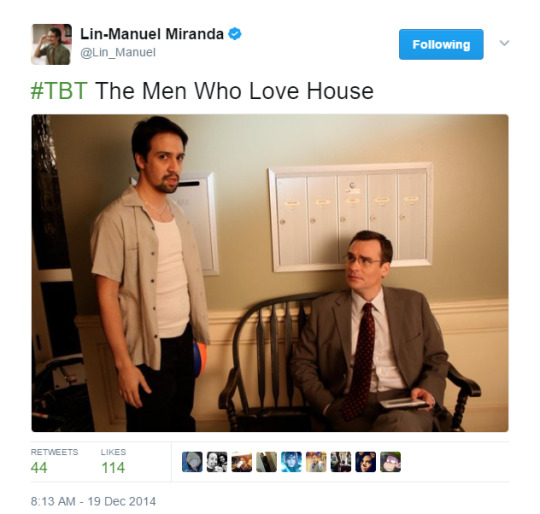
What is it? A medical drama that ran on Fox from 2004-2012.
What did Lin do in it? Lin guest-starred in season 6 episodes 1 and 21 as Juan “Alvie” Alvarez.
How do I find it? On DVD, Bluray and streaming, if you are that way inclined. Here is a BTS interview about Lin’s return in which he refers to Alvie as “the other woman” who comes between House and Wilson.
Sad Sad Conversation (2010)
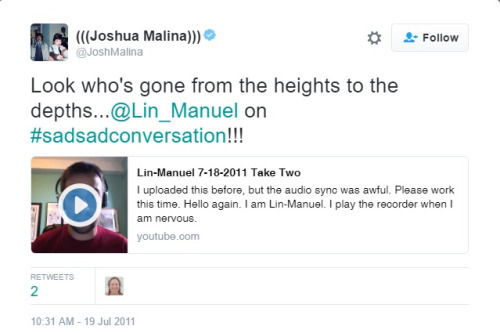
What is it? Hard to explain. Lemme quote from my own masterpost: Sadsadconversation was an experimental Youtube vlog series started by the comedian Michael Ian Black and the actor Josh Malina in which a bunch of semi-famous people trying to make it in the entertainment industry posted videos of themselves, in MIB’s words, “bitching about our careers and how badly everything was going”. The videos gained an interactive element as the “cast” grew - the participants responding to each other’s videos and to comments below the line. It became a bit of a group therapy session between internet buddies.
When was it on? 2011-ish.
What did Lin do in it? Lin was invited by Josh Malina to join and participated enthusiastically for a while, although as the other founder Michael Ian Black later said, “you never really fit in because you’re never sad.“
How do I find it? I have helpfully compiled a masterpost of all Lin’s appearances for your viewing pleasure.
Vivo (2011-)
What is it? An animated movie musical about a “capuchin monkey with a thirst for adventure – and a passion for music – that makes a treacherous passage from Havana to Miami to fulfill his destiny”, originally developed by Dreamworks Animation.
When was it on? Good question. Lin started working on Vivo around 2010, only for the project to flounder in pre-production. It was picked up again by Sony in 2016 and is now slated for a 2020 release, with a script written by Lin’s good friend and frequent collaborator Quiara Alegria Hudes.
What did Lin do in it? He wrote all 11 of the songs.
How do I find it? In movie theaters in late 2020, if all goes well.
Tonys Awards Closing Number (2011)
youtube
What is it? The closing number of the 2011 Tony Awards, a patter verse written by Lin with the help of Tommy Kail which recapped the events of the ceremony itself.
What did Lin do in it? You can see Lin and Tommy writing the thing during the Tonys in this BTS video.
Modern Family (2011)
What is it? A comedy that’s been running on ABC since 2009.
What did Lin do in it? He guest-starred in episode 22 of season 2 as a dodgy salesman named Guillermo. My favourite thing about this whole deal is that he looked way too respectable so they had to give him a dodgy haircut and weird glasses.
How do I find it? On DVD, Bluray and streaming, if you are that way inclined.
Bring It On (2011-2012)

What is it? A musical very very loosely based on the movie of the same name, directed by In the Heights and Hamilton choreographer Andy Blankenbuehler, with a libretto by Jeff Whitty and music and lyrics by Tom Kitt and Amanda Green.
When was it on? Bring It On premiered in Atlanta in 2011 and toured the US before playing a limited engagement on Broadway in 2012.
What did Lin do in it? Lin wrote about half the music and lyrics in collaboration with Tom Kitt and Amanda Green.
How do I find it? There’s a cast recording which is available for purchase and on Spotify. Here is a sizzle reel of clips from the Broadway production. Here is Lin and a few cast alumni doing selections from It’s All Happening at Ham4Ham.
The Odd Life of Timothy Green (2012)
What is it? A Disney fantasy comedy drama film starring Jennifer Garner.
What did Lin do in it? Lin played Reggie, a botanist who was old friends with Jennifer Garner’s character.
How do I find it? On DVD, Bluray and streaming, if you are that way inclined.
Merrily We Roll Along (2012)
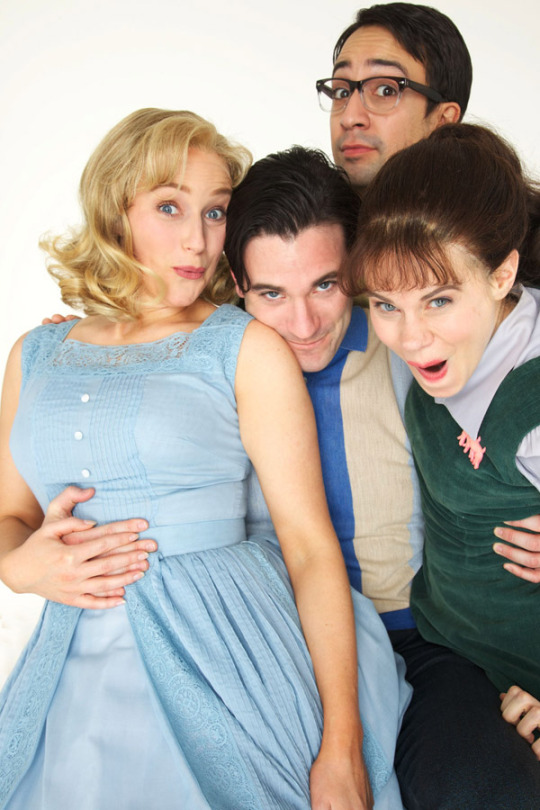
What is it? A musical with music and lyrics by Stephen Sondheim that was directed by Hal Prince. It opened in 1981 to disastrous reviews and closed after 16 performances.
When was it on? In 2012 Encores mounted a limited concert production incorporating significant revisions which ran in February of that year.
What did Lin do in it? Lin played one of the main characters, lyricist Charley, at the request of Stephen Sondheim.
How do I find it? Miraculously, there’s a cast recording which is available for purchase and on Spotify. You can see some clips from this production here and here.
Tony Awards Opening/Closing Number (2013)
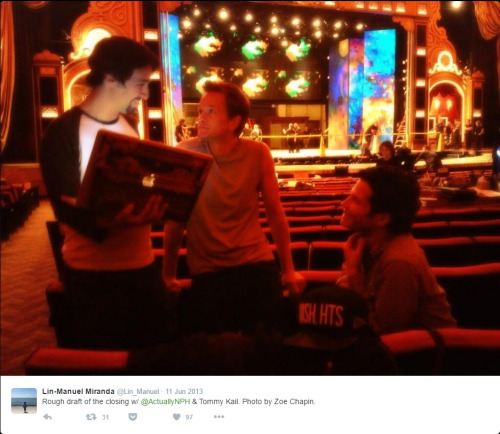
What is it? Lin teamed up with Tom Kitt to write “Bigger”, the opening number of the 2013 Tony Awards. He also repeated his 2011 trick with the closing number, but this time with a twist - he and Tommy rewrote Empire State of Mind by Jay-Z and Alicia Keys to fit the events of the evening as they happened. (“Bigger” was an enormous success and won Lin his Emmy.)
How do I find it? Here’s the opening and here’s the closing.
How I Met Your Mother (2013)
What is it? A sitcom that ran from 2005 to 2014 on CBS.
What did Lin do in it? He guest-starred in episode 11 of the final season as Gus, a fellow passenger on the bus with Marshall. (Fittingly, an episode written entirely in rhyme.)
How do I find it? On DVD, Bluray and streaming, if you are that way inclined. Here’s a small clip from Lin’s appearance.
Do No Harm (2013)
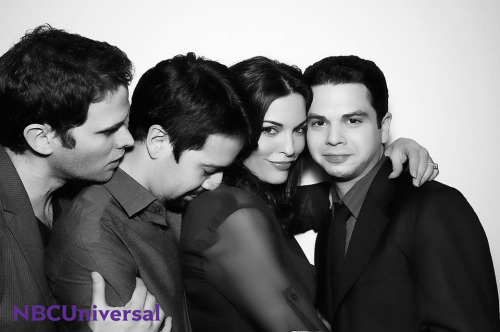
[Don’t ask me why this photo is the way it is. Let’s just say it made the series look a lot more interesting than it actually was.]
What is it? A very short-lived medical drama that was cancelled by NBC after airing only two episodes due to horrific ratings. There were 13 episodes filmed.
What did Lin do in it? Lin played Dr. Ruben Marcado, a pharmacologist who is friends with the main character (played by Steve Pasquale). In his own words:
Do No Harm was like a writing residency for me. It was a bad NBC show and I was sixth on the call sheet and I took the job because I was like, it shoots in Philly and you’re going to be killed off in the 11th episode. So it was like signing a potential seven-year contract, which I was not interested in doing or going to L.A. I wanted to have time to write. I would have days free in Philly to write.
How do I find it? Should you wish to watch it, the show is available on NBC.com, Hulu and Amazon. Here’s a clip of Lin doing technobabble like he’s been in sci-fi all his life.
200 Cartas / Looking for Maria Sanchez (2013)
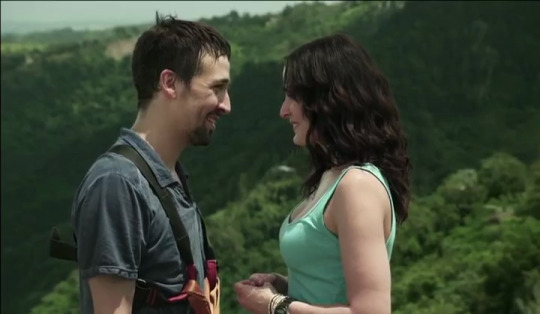
What is it? An indie romcom about a struggling Nuyorican comic book writer who falls in love at first sight with a woman named Maria Sanchez and goes on a journey to Puerto Rico to find her. Also starring former Miss Universe Dayanara Torres, and Jaime Camil.
When was it on? Limited release in 2013 in New York, Puerto Rico and the Philippines. The film also played a bunch of festivals.
What did Lin do in it? He played the main character, Raul.
How do I find it? It is available on DVD, although you will have trouble finding it. I have also heard that it is available on HBO Go and would appreciate confirmation. Here’s the trailer with English subtitles.
Aristotle and Dante Discover the Secrets of the Universe (2013)

What is it? An award-winning coming-of-age YA novel about queer Latinos set in Texas.
What did Lin do in it? He read the audiobook.
How do I find it? Here it is on Amazon, Audible and Audiobooks.com. Here is an excerpt of Lin reading it.
21 Chump Street (2014)
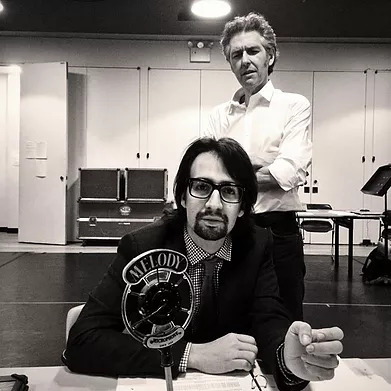
What is it? A 15-minute musical based on a true story reported by This American Life, starring Hamilton’s Anthony Ramos.
When was it on? One night only in 2014.
What did Lin do in it? He wrote the musical.
How do I find it? There’s a cast recording which is available for purchase. You can also buy the video of the live performance here. Here’s a taster of the first song. Warning: incredibly catchy.
…tick tick BOOM! (2014)
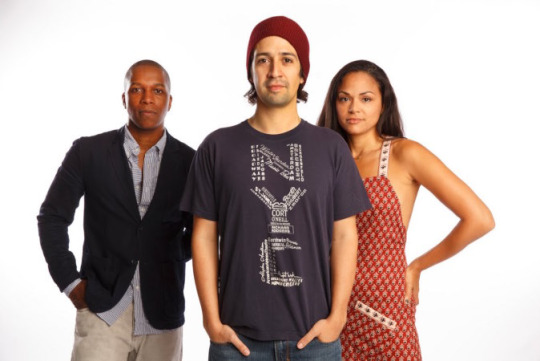
What is it? An autobiographical one-man musical by Jonathan Larson, adapted into a 3-actor piece after his death.
When was it on? Encores mounted a production starring Lin as Jon in June 2014 with the other parts played by Leslie Odom Jr and (at Lin’s invitation) Karen Olivo.
How do I find it? Unfortunately there is no cast recording. There are a bunch of clips on Youtube from the production though: here and here. And you want to watch this dress rehearsal video.
Hamilton (2015)

What is it? Hamilton: An American Musical began its off-Broadway run at the Public Theater in 2015 and moved to Broadway - you know what, if you’re here, I assume you know.
When was it on? On Broadway at the Richard Rodgers since 2015, in Chicago at the PrivateBank Theater since 2016, on tour in the US since 2017, and at the Victoria Palace Theatre in London starting in November 2017.
What did Lin do in it? He wrote the book, the music and the lyrics and co-arranged the music with Alex Lacamoire. He also starred as Hamilton during the off-Broadway production and the first year of the Broadway run, and in the #andpeggy company for the Puerto Rican stops on their tour.
How do I find it? See above. The cast album is available to purchase everywhere and on Spotify. Here are some clips from the off-Broadway and Broadway productions and from Chicago.
Ham4Ham (2015-2016)
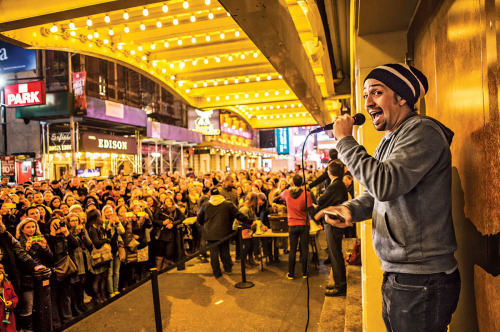
What is it? In hindsight, difficult to explain. Ham4Ham was originally the name for the live Hamilton lottery outside the Richard Rodgers. Due to the number of people who showed up to the first one, Lin and Tommy Kail decided to do a little something for the waiting crowd. The frequency and medium of the performances varied over time and they’ve now stopped being a regularly scheduled thing but there are over 130 for you to enjoy in clip form.
When was it on? The very first Ham4Ham took place before the first preview performance of Hamilton on Broadway. The very last featuring Lin was on the day of his last performance.
What did Lin do in it? He organised and hosted the majority of the Ham4Hams and performed in quite a lot of them.
How do I find it? I’m glad you asked. Here is a comprehensive masterpost for your viewing pleasure.
Star Wars: The Force Awakens (2015)
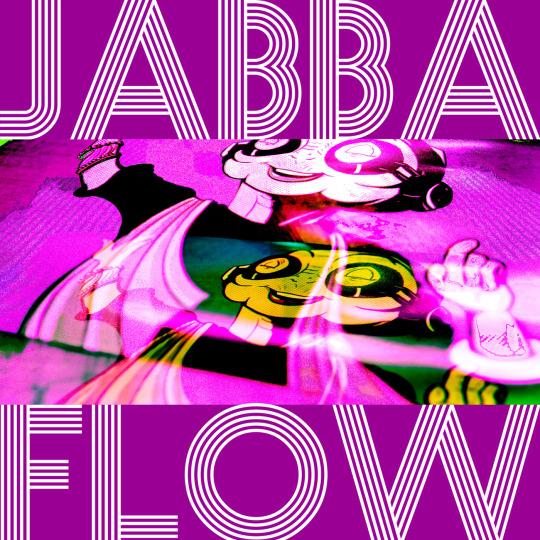
What is it? Lin jokingly offered to write the cantina music for Force Awakens when he met JJ Abrams in 2015 and JJ Abrams took him up on it. (He did not tell the Moana people that he’d taken on yet another gig while he was starring in Hamilton and writing songs for Moana.) The song, as described by the Star Wars Wiki:
A lyrical song performed in Huttese, "Jabba Flow" was named after Jabba Desilijic Tiure, a Hutt crime lord. It's opening verse began by repeating "Oh, Jabba," followed by a repeated "No bata tu tu, muni, muni," which roughly translated as "No, lover, lover. It wasn't me," in Galactic Basic. The song featured mellow instrumentals, which included a hypolliope horn cluster, a seven-string hallikset, and a xyloxan.
What did Lin do in it? Lin co-wrote the song and sings on it.
How do I find it? The track is available for purchase and on Spotify. There’s also a Rick Rubin remix. Here’s Lin and JJ performing it on Star Wars Day.
Hamilton: the Revolution (2016)

What is it? Hamilton: The Revolution (aka the Hamiltome) contains both an annotated libretto of Hamilton and a moving, engaging account of the making of the show written by Lin’s good friend Jeremy McCarter.
What did Lin do in it? He contributed the annotations (which are not the same as the ones on Genius) and read them in the audiobook.
How do I find it? There is an ebook but I don’t recommend it. (This is a gorgeous book and the ebook doesn’t do it justice at all.) The actual book can be bought wherever you buy books. Here’s the audiobook.
Drunk History (2016)
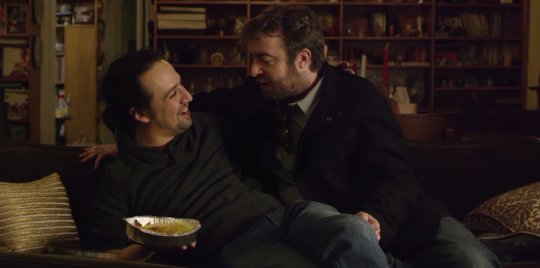
What is it? A comedy series produced by Comedy Central which features comedians getting sloshed and retelling historical events, and having that retelling simultaneously re-enacted by other famous people.
What did Lin do in it? Unusually, the show devoted the entirety of season 4 episode 9 to Lin telling the story of Alexander Hamilton, being hyperverbal and giggly, singing loudly and drunk dialing people.
How do I find it? You can find the episode on DVD and via various streaming sites. Here are some clips from the episode.
Saturday Night Live (2016)
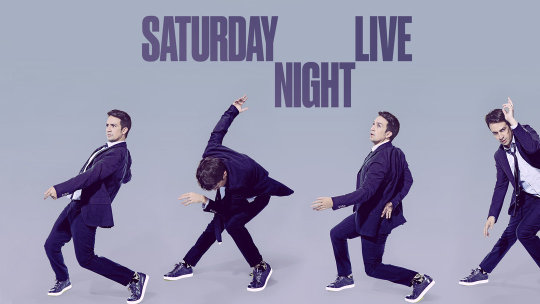
What is it? An American institution. For fellow non-US people, SNL is a late night TV sketch comedy/variety show which features a different celebrity guest host every episode.
When was it on? Lin hosted the second episode of season 42 which aired in October 2016. His opening monologue, which was built off My Shot from Hamilton and written the night before the show by him with the help of some of the SNL writers, went viral both because of its virtuosity and because it directly attacked one of the presidential candidates. Other notable sketches included one about Stranger Things, a sketch about a Latino immigrant which was almost entirely in Spanish, and an ode to high school cast parties.
How do I find it? If you are in the US you can watch the sketches and opening on NBC’s Youtube channel. I believe the episodes themselves are available for purchase on iTunes. The ode to high school cast parties is also available for purchase as a single.
Hamilton’s America (2016)

What is it? A movie-length documentary about the making of Hamilton and about Hamilton the man, featuring performance footage and interviews with everyone from Obama to Nas.
When was it on? Hamilton’s America premiered at the New York Film Festival and then on PBS in October 2016.
What did Lin do in it? He was one of the producers, featured heavily in the documentary as a performer and interview subject, and conducted some of the interviews in the film.
How do I find it? If you are in the US you can stream it on PBS’ website. Otherwise here are a bunch of clips on YT.
Moana (2016)

What is it? A Disney animated movie musical set in the South Pacific and starring Pasifika/Maori actors in all the speaking roles.
What did Lin do in it? He co-wrote the music with Mark Mancina and Opetaia Foa’i and performs on the track We Know the Way.
How do I find it? The movie’s out on DVD, Bluray and streaming and as someone from that region I really do wholeheartedly recommend it. The soundtrack can be purchased wherever you buy music and it’s also on Spotify.
The Hamilton Mixtape (2016)/#hamildrops (2018)
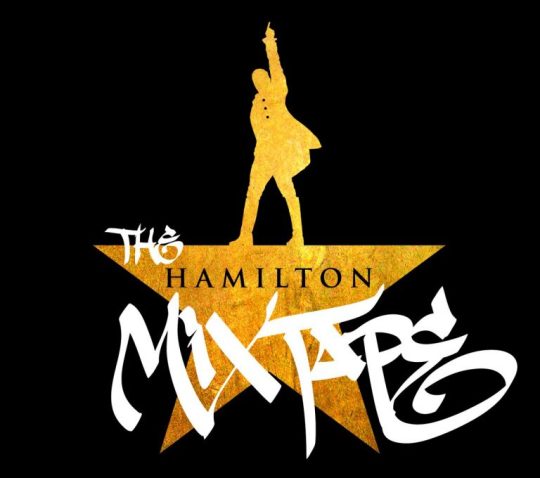
What is it? A collection of demos, remixes and songs inspired by Hamilton, some with music videos.
What did Lin do in it? He co-produced the album, organised artists and basically oversaw the whole operation. He also contributed some unpublished Hamilton demos and a deeply personal verse to the track Wrote My Way Out. He performs on Found/Tonight and Cheering For Me Now.
How do I find it? The album can be purchased wherever you buy music and it’s also on Spotify. Here is a link to the Hamildrops.
Ducktales (2017-)

What is it? Reboot of the 80s animated series with an all-star voice cast.
What does Lin do in it? Lin plays Gizmoduck, aka Fenton Crackshell-Cabrera — a superhero who protects Duckburg, but also spends his days as an intern for Scrooge McDuck’s personal mad scientist, Gyro Gearloose.
How do I find it? It airs on Disney XD/Disney channel.
Curb Your Enthusiasm (2017)
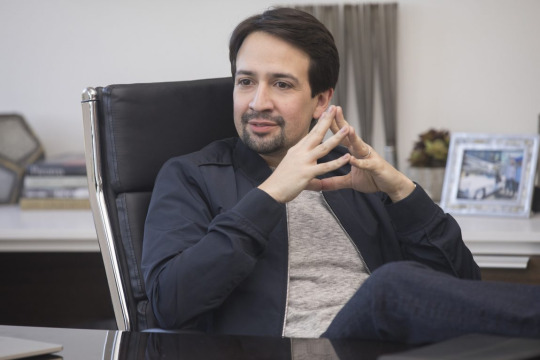
What is it? HBO comedy starring Larry David.
What did Lin do in it? He guest-starred in 2 episodes of season 9 as an AU mean version of himself, complete with America Ferrera playing Vanessa.
How do I find it? On DVD, Bluray and streaming, if you are that way inclined.
Gmorning, Gnight! (2018)

What is it? Collection of Lin’s good morning / good night tweets, illustrated by Jonny Sun.
How do I find it? Available in all the usual places books are sold. Also available as an audiobook read by Lin.
Mary Poppins Returns (2018)
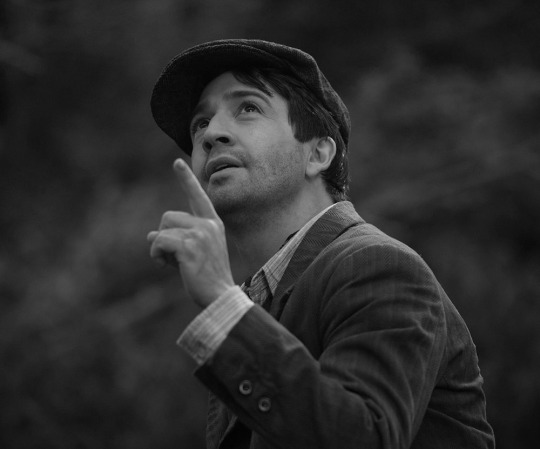
What is it? A Disney musical fantasy comedy film directed by Rob Marshall adapting more of P L Travers’ Mary Poppins books. (So it’s a sequel to the 1964 classic, not a remake.) The film stars Emily Blunt, Meryl Streep, Ben Whishaw, Emily Mortimer, Angela Lansbury and Colin Firth.
When does it come out? It is schedule for release on 25 December 2018.
What does Lin do in it? Lin plays Jack the lamplighter, a friend of Mary’s. He’s doing a lot of singing and dancing.
His Dark Materials (2019)
What is it? BBC/HBO adaption of the beloved Phillip Pullman trilogy with an all star cast and crew. Already renewed for a second season.
When does it come out? No idea at this stage. Season 1 was filmed in Wales in 2018.
What does Lin do in it? Lin plays the balloonist Lee Scoresby.
Fosse/Verdon (2019)
What is it? Limited series about the famous choreographer and his muse.
When does it come out? No idea at this stage.
What does Lin do in it? He is executive producer. The rest of the Hamilton Cabinet are also heavily involved.
In the Heights (2020)
What is it? The long-awaited movie adaption of Lin and Quiara’s show, directed by Jon M Chu.
When does it come out? June 26, 2020!!!
What does Lin do in it? Lin is co-producing and might possibly write a few new songs. (I say this because he wrote extra music the last time the movie was in development back in 2010.) He has the last word on casting.
Kingkiller Chronicle (?)
What is it? A series of fantasy novels by Pat Rothfuss which are being adapted into films and a TV series. John Rogers has been announced as showrunner for the latter.
When does it come out? No idea at this stage.
What does Lin do in it? Lin is the “creative producer” of the whole enterprise alongside Pat Rothfuss and will be in charge of writing all the music. Rothfuss has expressed a desire for Lin to also be involved as an actor.
The Little Mermaid (?)
What is it? Disney’s live-action remake of the classic animated film.
When does it come out? No idea at this stage.
What does Lin do in it? He’s not quite sure himself, although Alan Menken is going around telling everyone that he and Lin will be writing new songs for the movie. The rest is all rumour-mill stuff.
Tick Tick...Boom (?)
What is it? A film adaption of the musical by Jonathan Larson (the one Lin starred in a production of in 2014).
When does it come out? No idea. Filming hasn’t even started yet.
What does Lin do in it? This will be his directing debut!
Cameos and guest appearances:

The Sopranos (2007)
Legally Brown: the Search for the Next Piragua Guy (2008)
The Polar Bears (2012)
Submissions Only (2012)
Smash (2013)
Studio Heads (2014)
Inside Amy Schumer (2016)
Difficult People (2016)
Love Make The World Go Around (2016) (and video)
Speech & Debate (2017)
My Brother My Brother & Me (2017)
Residente (2017)
BoJack Horseman (2017)
Bartlett (2018)
#lin manuel miranda#masterposts#don't ask me how long this took#anyway#happy almost 2500 followers!#thank you all
1K notes
·
View notes
Text
Instrumental Soul
Rolled by: Me For: A., J., D. and the rest Late Summer 2018 TRT: 1h19m21s
There are a few instrumentals I’ve been putting on evry tape for years…Bar-Kays’ “Knucklehead”, Kool & The Gang’s “Street Corner Symphony” and Ike Turner’s “Funky Mule”. For awhile I’ve been thinking about a mixtape of all instrumentals. Normally I like making tapes that go off in all directions. I don’t usually do themes, altho I think of a lot of them. I have almost never done a tape of tunes from mostly just one genre. I like this one a lot tho. Maybe I’ll do more. Settle down a bit, stop childishly trying to impress you with my hard lefts & flying leaps.
Once I finally started, this tape came together super-quick. It wasnt hard to find another hour of funky jazzy soul-ey instrumental toons. I assumed, as you might, confronted with a mix calld Instrumental Soul, I’d eventually get around to some Booker T. and the M.G.’s. Somehow, tho, they are not here…but their influence is defnilly present.
I usually try to make my mixes fit on an old-school 74-minute ceedee…you know, just like the 9th Symphony. I like to use the most restrictive definition, even tho I’ll ultimately be dumping it onto an 80-minute CDR. Or, these days I’d as soon keep it as file, but my friends they all still like getting the “physical” disk, don’t ask me why. Anyway, this is all to say I broke that rule this time around. I already weeded out a bunch of stuff I wanted to put in to get it under the 80 minute mark (yes I’m already planning a Part 2), and I didnt want to lose any more.
Another thing I did different with this one is give the songs some room to breathe with a couple seconds of silence between each one instead of running them all together like I usually do.
Here we go….
Roger & the Gypsies “Pass The Hatchet Pt. 1” Seven B 7001 (1966)
Happy hypnotic groover from New Orleans funkmaster Eddie Bo, a dude with really excellent hair. Like a lot of what’s on here, he came to my attention originally thru Funky16Corners. The original 45 costs mad cheddar but it’s on lotsa collections…various little indie N.O. funk comps and even the Desperado soundtrack. I took it from Mojo’s “Southern Soul” disc. I don’t think it’s on any of the main Eddie Bo collections, Funky Delicacies’ Funky Funky New Orleans or Vampisoul’s In The Pocket with Eddie Bo or etc. It’d be nice if there were something truly comprehensive out there, but ya know.
The J.B.’s “Pass The Peas” From Food For Thought (People 1972)
Maybe part of the reason the JB’s have been looped so often is that they sound like a loop to begin with. No one can lock like they could. Long solo from leader Fred Wesley…I love a good trombone solo, but the player has to have a fabulous tone and mad technique, both which of course the legendary Fred Wesley has by the bucketful. What he doesnt have is the vocabulary of a jazz player—it’s pure funksoul; it stays inside its box. You might find that a little repetitious after some 36 bars but I don’t care I don’t care. Some organ in the background from the Creator himself. I playfully referred to the instrument as the “pipes,” as in, “Is that James Brown on the pipes?” and Jen would not have it. “It’s a Hammond organ!” she yelled, “There’s no pipes!!”
Some of my sources for this tape are vintage elpees and some, like this one, are slightly suspect vinyl re-issues. They look good but questions like Are they properly licensed? and Were they mastered from the original tapes or some inferior copy? are anyone’s guess. I don’t know, it sounds good to me. That’s how a lot of this type of material is available these days. Many of these albums never got any official re-issues, digital or analog. You can’t be too picky unless you want to lay out for first pressings.
Dizzy Gillespie “Matrix” From The Real Thing (Perception 1970)
The jazz legend (is legend a strong enuf word?) ’s soul-flavord The Real Thing album gets my highest recommendation. A heat rock if ever there was one. You wanna hear Dizzy Gillespie and his fine collaborators blow over hard beats from a funky rhythm section? Yes you do.
Eddie Harris “Listen Here” From The Electrifying Eddie Harris (Atlantic 1968)
Some cool elevator jazz from the electric saxophonist once referenced in a Beastie Boys hit. Is it fair to call it elevator music? Does that term even mean anything other than an offhand dis? When I say it, I’m talking about something specific, at least in my own head. Elevator music, like disco, is something I wasnt supposed to like but which I now have a growing appreciation for. Maybe I shud make a tape of all elevator music, like the stuff I used to hear at Kohl’s when I was a kid. Maybe I’ll make it for my friend J. who likes to listen to the smooth jazz station when he’s hungover.
This tune evokes a train moving underground, and it might inject some joy in yer commute if you put it in your headphones.
J. C. Davis “A New Day (Is Here At Last)” New Day 1373 (1969), remixed and re-issued on A New Day! The Complete Mus-I-Col Recordings Of J. C. Davis (Cali-Tex 2005)
My brother A. put me on to this dude. The saxophonist and bandleader (not to be confused with the other J. C. Davis who played guitar with Hank Ballard and the Midnighters) backed James Brown in the early 60s and around ’69 released a few singles on his own label. Around ’05, Josh Davis AKA DJ Shadow went back to the studio in Columbus, Ohio, where those records were made and he remixed them “on the original mix board” because he’s the king of the nerds. That irresistible smooth, slightly edgy sax sound crooning over haaard mutherfuckin drums begging to be sampled—and they have been!—with that cool 60s chickenwing funk guitar & organ.
Tom Scott and the L.A. Express “Sneakin’ In The Back” Originally from their self-titled album (Ode/Epic 1974), later appearing on volume whatever of the Ultimate Breaks ’n’ beats (Street Beat 1990)
A little misterioso now. This smoothie I got from my bootleg version of Lenny Roberts & Lou Flores’ collection of evry essential breakbeat ever. No doubt Tom Scott & the L.A. Express would find their way to my elevator music tape too.
Willie Bobo and the Bo-Gents “Do What You Want to Do” From Do What You Want To Do… (Sussex 1971)
Of course it was Larry who first introduced me to this album. Try to be unhappy listnin to this sawng. Try. Classic example of that East Side salsa n soul I love.
Freddie Hubbard “Backlash” From Backlash (Atlantic 1967)
Again, a great jazz artist doin’ a record in a funksoul-influenced style. Freddie Hubbard is one of my favorite trumpet players, and this tune scorches.
Bar-Kays “Knucklehead” The flip side of “Soul Finger”, Volt 168 (1967)
I bought the Soul Finger album (yet another suspect re-issue) becuz the title track is essential, but this hard hitter is my faverit tune on it. The B side wins again!
Dizzy Gillespie “Soul Kiss” From The Real Thing (Perception 1970)
Another tune from The Real Thing, a more frantic one, with kissy noises from the trumpet. By the way, if you sound like this when you kiss, I’m pretty sure you arnt doing it right.
The Mohawks “The Champ” Pama PM 719 (1968)
It’s called “Champ” but it sounds more like “tramp” a la Carla Thomas. The band is doin’ the Booker T., and that screamin organ riff by Alan Hawkshaw (sampled many, many times of course) over top of it is un dee nigh uh bull.
Zap-Pow “Soul Revival” Jaywax 45 (1974?). Also on the album Revolutionary (Roosevelt 1976?), but most likely to be found on the compilation Funky Kingston: Reggae Dance Floor Grooves 1968–74 (Trojan 2002)
Another gem brought to my attn by Funky16Corners. Heard it on the blog and had to run out right away and buy the comp just for one song. Probably the tightest record on here next to the JB’s. Usually filed as reggae due to its place of origin, but this is str8 funksoul.
Kool & The Gang “Street Corner Symphony” From Light Of Worlds (De-Lite 1974)
I love it when Kool & The Gang does their fake jazz thing. Got soul-jazz from both sides of the fence on here. At the end the sax quotes “My Favorite Things” (a nod to Trane I assume) which always cracks me up.
Ike Turner & the Kings Of Rhythm “Funky Mule” From A Black Man’s Soul (Pompeii 1969)
Ike & Tina Turner made a lot of really cool records and a lot of mediocre ones (and I wish I knew which was which), and these days they are scattered across a hundred seedy bargain compilation ceedees. The act has never been anthologized properly, maybe due to Ike’s reputation (which I’m sure is well-deserved…recent attempts to rehabilitate him kind of piss me off…tho also irritating is the popular image of him as a cartoonish monster, mostly due to the movie, which even Tina said didnt happen like that. Evrybody does good and bad things in their life. The good things don’t take away the bad things and vice versa, and you can dig music with eyes open to the fact that some of the ones who made it were not cool people). I pickt up one such random comp choosing it mostly for the title: I Smell Trouble!!! (yes with three exclamation points !). It included this hard funk instrumental that cracked my head open wit a axe. It’s one of those songs where they just crammd in evry badass riff they could think of. Again, hard, hard muthafuckin drums, driving horns growling and belching smoke, funkee geetar, a busy bassline dancing underneath it all. Wish I knew who the players were but no credits given.
Dr. Octagon “Bear Witness” From Dr. Octagonecologyst (Bulk 1996)
Dr Octagonecologyst is a goofball boom-bap classic. I remember hearing Blue Flowers on AMP. For a while that was the best or one of the only good things on MTV, and it turnd me on to a lot of cool stuff.�� This instrumental showcases DJ Q-Bert’s scratching and a bevy of funky breaks. The sampled battlecry, “Creating rap music ’cause I never dug disco” sure sounds like Chuck D (thanks to some processing) but it’s actually an obsure MC from the 80s called 4-Ever Fresh. Automator and a supercrew of DJ/producers including Prince Paul & Shadow would revisit this track a few years later on Handsome Boy Modeling School’s equally classic first album.
James Brown “Spinning Wheel” From Sex Machine (King 1970)
James Brown’s mellow organ version of Blood, Sweat & Tears’ Spinnin Wheel is an unsung classic.
Bill Doggett “Honky Tonk Pt. 2” King 4950 (1956)
Long ago, my former coworker K. turnd me on to Bill Doggett and this much-coverd happy, handclapping, sax-driven early rocknroll hit. I took it from this comp.
Doc Bagby “Crazy Chemistry” Okeh 4-7098 (1958)
My good, good friend M. once gave me, for my birthday maybe, when I was like 20, a big stack of 45s from his own collection. I still prize them to this day. This was one. Demented carnival music with Wurlitzer organ and bouncy guitar.
The 45 King “Get Funky” On The Lost Breakbeats Volume 1 & 2 (The Yellow Album) (45 King Records 1983)
Super duper beat maker the 45 King. Lotsa gems on this collection, which I got on bootleg download.
Hugh Masekela “Grazing In The Grass” From The Promise of a Future (Universal City 1968)
It’s a gas. The original, instrumental version by South African trumpet player Hugh Masekela. Only 2 anna half minutes. Supposedly recorded just to fill time on the album. Huge hit. Gotta have more cowbell, more overdriven brass, more POP!
The Meters “Sophisticated Cissy” Josie 1001 (1968), the band’s first single I think. Also on The Meters
Aww, such a badass slow groove, makes you say “UH!” KRS-One and Scott LaRock sampled this on “Essays On BDP-ism”, a very cool record made just before Scott LaRock’s death in 1987 and unreleased until 2000. I’m surpised it hasnt been sampled more. Great way to come in for the close.
Ray Charles “Doodlin’” From The Great Ray Charles
Ray Charles and his associates do a sweet version of the Horace Silver tune, with a muted trumpet by John Hunt and tenor sax David Newman. I was first introduced to Ray Charles’s jazz material and this tune in particular via a tape in my brother’s car he was way into around, oh, twenty years ago. A tape he got from his friend G. probably. Ray Charles made a couplefew jazz albums. Highlights from them appear on this odd artifact, with its yellow cover and monochrome portrait that looks like a zeerox. With a title like The Best of Ray Charles, you might expect material like “What’d I Say” and “Georgia” rather than 6 instrumental jazz tunes. Nevertheless it is highly recommended.
Boom!
0 notes
Link
At 12:00 am on Friday morning, Eminem casually tweeted out a link to a surprise new album, Kamikaze, and set the late-night internet on fire.
The 13-track album, streamable on Apple and Spotify, is the rapper’s first release since his 2017 LP Revival. Produced by Eminem and Dr. Dre, it pays homage to the classic Beastie Boys album License to Ill and features collaborations with Joyner Lucas, Jessie Reyez, Royce da 5’9”, and Bon Iver’s Justin Vernon.
More importantly, it features Eminem in full-on old-school mode, dropping a litany of classic Marshall Mathers verses. It’s an occasionally uneven album, but it’s full of fire and full of Eminem’s always-impressive skill. It also reminds us, as few Eminem moments have lately, why so many hip-hop fans believe he’s the GOAT.
This might sound surprising after the negative reception to Revival, which drew the worst critical response of Eminem’s career despite sporting flashy collabs with the likes of Beyoncé and Ed Sheeran. But on Kamikaze, Eminem is clearly back on his bullshit, and so much better for it.
Throughout Kamikaze, Eminem takes aim at the stagnant feel of recent rap and its purveyors.
From the very first track, “The Ringer” — which opens with a brutal litany of rap disses before seamlessly shifting to the rapper’s well-established anti-Trump rage — we get Eminem at his self-aggrandizing, self-deprecating, dizzyingly self-assured best. Along with savaging a bunch of people (“Lil Pump, Lil Xan, imitate Lil Wayne,”) he devotes a whole verse to professing himself mystified by recent rap trends, à la “Gucci Gang,” with their “subpar bars” and “choppy flow.”
Em makes the point again and again that he’ll never stint us of a good rhyme or a well-crafted run-on lyric. In stellar tracks like “Lucky You” (his utterly fire collab with Joyner), “Not Alike,” and “Fall,” he asserts his confidence that he still has a place in rap — and that rap desperately needs him.
He does this musically, especially through the use of trap beats (“Not Alike”) and musical references to other artists. By using duplicated clips and structural mimicry, he summons musical memories of Kendrick Lamar, Drake, and Migos to ironically illustrate how overly copied their work has become, and how lazy it is to simply lay down a weak verse over someone else’s song structure.
Lyrically, so many people get dissed on Kamikaze that it’s easier to talk about who doesn’t. Naturally, Em’s longtime mentor Dr. Dre, who co-produced, is safe, as are his album collaborators. But “if you ain’t Joyner, Kendrick or [J.] Cole or Sean then you’re a goner,” he promises. By the time the album ends, pretty much everyone is dead:
Eminem just dissed:
Tommy from Rugrats John Wick Lil Yachty Eddie Murphy MGK Tyler, The Creator Drake Charlamagne Bill Gates Joe Budden Trump Mike Pence Ellen Ohio Chicago Bears My moms spaghetti
And he ain’t done yet
— Kraken (@SinktheKraken) August 31, 2018
Eminem went in on Tyler, Budden, Hopsin, Logic, Drake, MGK, Tech, Xan, Yachty, me, my dog, my 6th grade teacher, the state of Delaware, an entire school of goldfish, the aurora borealis, industrial microwaves, semen, ewoks, fishing lines…
— KS3T (@sIipspace) August 31, 2018
He’s also good to the likes of Hopsin, Cypress Hill, and Travis Scott. (Kathy Griffin also gets a shoutout on the title track: “Kathy Griffin, stackin’ ammunition / Slap the clip and cock it back on competition.” She has already tweeted her delight over the reference.)
But there’s narcissism in Eminem’s benevolence, too. “Don’t tell me ’bout the culture,” he sings in “Fall.” “I inspired the Hopsins, the Logics, the Coles, the Seans, the K-Dots, the 5’9s, and, oh, brought the world 50 Cent” — the latter a reference to Eminem signing Fiddy onto his label and jumpstarting his career.
Notably, there’s one artist who briefly shared Em’s Kamikaze spotlight, despite not performing on the album: Tay Keith, who produced “Not Alike,” Eminem’s collaboration with Royce da 5’9”.
Keith is a wunderkind, a 21-year-old producer from Memphis who just graduated college but who’s already worked with major artists — including Drake. That’s why Drake’s song “Nonstop,” from his recent album Scorpion, begins with the low-level introduction, “Tay Keith, fuck these ni**as up.”
This line is Keith’s producer tag — the verbal equivalent of an artist’s signature. Including a producer’s signature tag on a song or album they contributed to is a longtime industry trend, recently on the rise, to shout out the creative collaborators working behind the scenes. It’s also a great way to call attention to a producer’s specific style and aesthetic.
Keith’s tag of “Tay Keith, fuck these ni**as up” has become something of a meme since Scorpion. So when Royce shouted it out on his collab with Eminem, “Not Alike,” fans turned heads because it was such an unexpected thing to hear on an Eminem album — and Keith, who did indeed produce the track, was such an unexpected collaborator. In working with Keith, Eminem is clearly trying to send a message: He’s not only on top of his game, but he’s working with the best and brightest in the industry. Of course, it might not entirely be working — see Twitter’s skepticism that he’s just an old fogey trying to fit in with the cool kids — but we laud him for trying.
Of course, since this is Eminem, he’s also ready to diss himself. “What I’ll never be is flawless,” he assures us; “all I’ll ever be is honest.” In typical fashion, his most boastful songs are also inundated with references to his failures and errors. Throughout Kamikaze’s second track, “Greatest,” he interpolates Kendrick Lamar’s “Humble,” most brilliantly when he self-mockingly notes, “Revival didn’t go viral!”
The theme of overcoming Revival’s failure reverberates throughout the album, but Eminem also second-guesses his way through his approach to relationships — most notably in “Stepping Stone,” when he addresses his now-defunct rap group D12 and his conflicted feelings about their dwindling friendships and fragmenting career trajectories. He also questions his personal approach to combating President Trump.
Referring to his incendiary anti-Trump freestyle “The Storm,” Eminem notes in “Ringer” that while he feels committed to critiquing the administration, he feels more sympathy now with the Trump-voting fans he initially rejected: “If I could go back, I’d at least reword it / and say I empathize with the people this evil serpent sold the dream to that he’s deserted.”
But while Eminem is letting his liberal colors show in reference to Trump, elsewhere on the track, they’re a lot muddier. Eminem is in a familiar place in terms of “shock rap” doubling poorly as social critique: He’s still dropping homophobic slurs and frequently deploying homophobic gay panic without apology; on Kamikaze, the virulent misogyny of his past, which has often been presented as tongue-in-cheek, gets funneled into a darkly satirical critique of virulent misogyny called “Normal.” In it, he takes on the persona of a violently possessive, controlling boyfriend — arguably in order to critique toxic masculinity, but because this is Eminem, you’re never quite sure. See, for example, his character’s confession that “I slipped up and busted her jaw with / a Louisville Slugger ’cause all’s it / really does is make our love / for each other grow stronger.”
He follows this up later with the pair of tracks “Nice Guy” and “Good Guy,” which both trade on the popular conception of the “nice guy” as an embodiment of the kind of entitled misogyny that leads to the violence we see in “Normal.” It’s not exactly groundbreaking, and as always, it’s so difficult to uncouple Em’s critique of misogyny from actual misogyny that it might as well be one and the same. But for what it’s worth, it looks like he’s at least read “Cat Person” like the rest of us.
The album finishes out with “Venom,” Eminem’s contribution to the soundtrack for the upcoming Tom Hardy superhero movie. It’s an anticlimactic, predictably overproduced note on an album that’s otherwise, well, spitting plenty of venom. But despite a few low notes, above all, Kamikaze reminds us loud and clear why Eminem is “a fucking invincible, indefensible, despicable difficult prick” — in the most compelling way possible.
Original Source -> Eminem’s surprise album Kamikaze is his best in years
via The Conservative Brief
0 notes
Text
Andalusian Holy Week and Tom’s “Grand Tour” of the Iberian Peninsula
My longest break this semester was in April around Easter, during what’s referred to as “Semana Santa” or Holy Week in Spain. The amount of vacation time we got for this holiday was certainly nothing to scoff at, just one day shy of a full two weeks off from school! Of course, I had to make the most out of so much free time, and I decided to spend it traveling.
My trip was 100% self-organized (transportation and lodging), self-planned (things to do and places to see) and self-financed (so logically, I kept everything as cheap as humanly possible), something I’m pretty proud of. To top it all off, I decided to make this adventure a solo one, partly because I wanted the freedom to do whatever I wanted, and partly because it’s hard enough to coordinate a trip to one city with multiple people, let alone a trip with 7 different stops!

Here was my itinerary:
0. Valencia
1. Granada
2. Sevilla (Seville)
3. Lisbon
4. Bilbao
5. San Sebastián
6. Madrid
7. Toledo
(From this map, it looks like I did an almost complete circuit of the Iberian Peninsula while intentionally excluding the Cataluña region. I did skip this area for a reason - I’d already been! See my blog on Barcelona here.)
Because most of my trips up until this point had been to other countries in Europe, I decided to stay in Spain this time around (the one exception being my stop in Lisbon, Portugal). I also strategically planed my visits to Granada and Sevilla to coincide with Andalusian holy week festivities. All throughout Andalucía (a community in Spain, similar to a state here in the US) there are festivities and processionals throughout the week of Semana Santa (Easter), so it was a great opportunity to visit those cities and experience such a unique and important element of Andalusian culture.
It’s been over a month since I got back from this trip, and I’m just now finally getting around to writing a post about it! And as you could probably imagine, it’s a pretty sizable post too, with just over 300 pictures (and trust me, there were at least double that amount on my camera roll before I started picking and choosing) so fingers crossed it won’t crash your phone/internet browser. I tried to fill this post with lots of details - possibly making it a little boring for some readers, which is totally okay! My justification for so much verbiage is I want to be able to look back at this blog later in life and remember my travels. If you’re not interested in the writing and just want to quick scroll through to look at the pretty pictures, I won’t be offended in the slightest :)
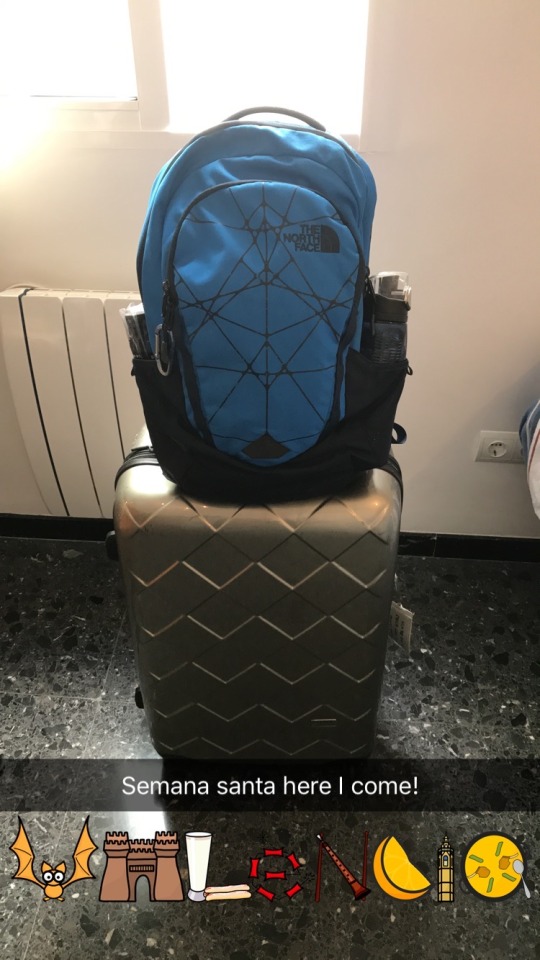
2 weeks, 7 cities, 1 Thomas. What could possibly go wrong?
1. GRANADA
A lot, actually. Well not really - just one thing. But a pretty major thing. Every millennial’s worst nightmare: I couldn’t charge my phone (gasp!)
Yeah, I know, you can groan and roll your eyes about how my generation is dependent on technology - I get it. However, when traveling alone in a foreign country, your phone is your lifeline. Not only does it serve as a camera (which is a convenience thing but not a necessity), it also serves as a map, translator, and emergency contact device (all of which are essentially necessities). Not to mention, I was traveling alone. So needless to say, having a functioning phone is important when traveling abroad!
After taking a train from Valencia to Granada and listening to music/texting most of the ride, my phone battery was pretty low. I wasn’t worried though, because I always keep a backup battery pack on me when I travel. I arrived at my AirBnB, got ready for bed, plugged my phone in to charge (or so I thought) and went to sleep.
The only problem was, my iPhone cord (for some inexplicable reason) chose that night of all nights to stop working. Being the dimwit I am, I just plugged my phone in overnight without bothering to see if it was actually charging. When I woke up the next morning and realized my phone was on 8%, I was an unhappy camper (to put it lightly). I needed my phone to navigate through the city and arrive at the Alhambra in time for my tour. If I was late, I would be denied entry, and I was not about to miss out on seeing it. The Alhambra is a famous Arabic palace, and is actually the most-viewed monument in Spain (see pic below).

Friends who previously visited raved about how absolutely beautiful the Alhambra was and how I had to take a million pictures there. Well - that’s not so easy if your phone is your camera and it’s on death’s doorstep! I pulled out every trick in the book to make my phone last as long as possible: battery saver mode, airplane mode, even turned the brightness completely down. Luckily, I arrived in time for the tour, but using the GPS brought my battery down to around 2-3%. Miraculously though, my phone lasted on such low battery for almost the entirety of the visit! Normally, my phone would drop that much battery percentage in three minutes, let alone three hours! Even though with the backlight off I could hardly see what I was taking a photo of, I got pictures of the majority of the tour, and I think all things considered, they turned out pretty decent!

It’s a bit hard to make out in this shot, but on many of the walls of the Alhambra, the word Allah, the name for God in the Islamic faith, is spelled out to adorn the walls.





Interesting tidbit that our tour guide shared with us - although these windows look to be the same distance from the center of the wall, they're actually intentionally mis-aligned by 2 centimeters (that is, if you could fold this wall down the middle, the windows wouldn’t line up just right). This is because the creators of the Alhambra believed that there is no complete perfection except their God Allah, and any attempt to create perfection was blasphemy. The palace was constructed with many very tiny and virtually undetectable, intentional architectural and geometric errors due to this belief.

Palacio de los Leones, perhaps the most famous room in the Alhambra.

My luck got a bit better when the tour started - I had a reasonably small group. In fact, it was just me and one other family. And believe it or not, the other family was from Valencia! We got along really well, made some nice small talk, and the dad even emailed me some photos after the tour because I told him my phone had died.
The weird earpiece thing I’m wearing in the picture above is the latest in tour-guide technology - the guide speaks into a microphone softly and we can hear her explaining history and other details while we wander around and soak in the sights. While this is convenient, I suspect the main reason they do this is so that snoopy passerby don’t get to hear the tour without paying.








Some beautiful views of the Albayzín, a historic district in Granada.





Jardines del Generalife






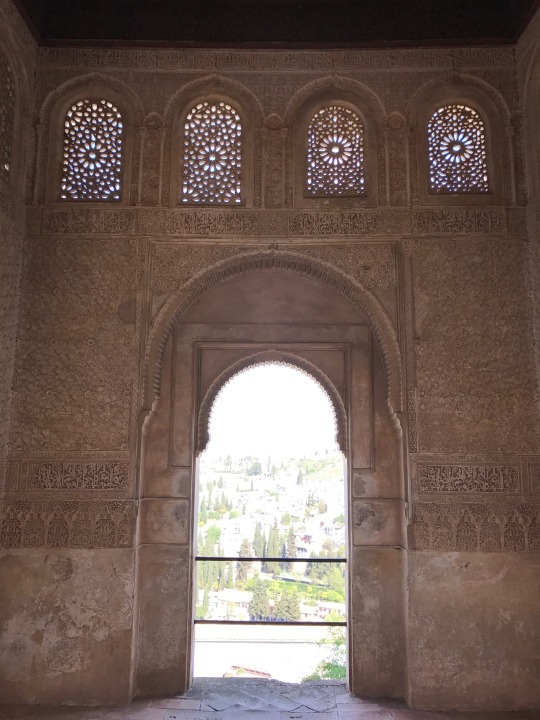

After this point in the tour, my phone finally gave out. However, I was all-in-all pretty impressed at how long it lasted with 2%, so I couldn’t complain. After the tour, the first order of business was to find a working iPhone cable (which was already difficult because most Spanish stores have weird hours, made even worse because it was a holiday) but eventually I found a charger at a sketchy mini mart and revived my iPhone. After that, I went to a bar to get a bite to eat. Although I didn’t think to snap a picture, I was reminded that I was truly in Andalucía when I ordered a drink and received free food that I didn’t even chose along with it. Although other areas of Spain have added tapas to their menus to try to reel in tourists, in their most authentic Andalusian form, tapas are free bites to eat that come with drink order, without you asking or choosing what you get. Cool huh?
After a quick siesta at my AirBnB, I paid a visit to the beautiful Cathedral of Granada






One of the many, many processions for Holy Week. Religious orders dress up and wear white robes and cone hats that I think look alarmingly similar to KKK outfits (but thankfully, there is no relation, and these processions far outdate the Klan anyways).
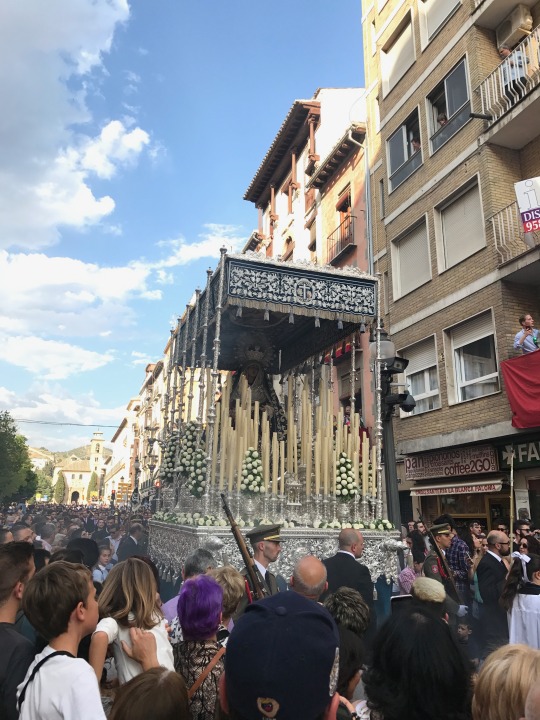
Many times in processions, members of religious orders carry an effigy of the Virgin Mary on a sort of pilgrimage. The candles you see are all real and lit, and the smoke is from incense.

Every so often, the procession stops at designated points and a vocalist sings a blessing in traditional Andalusian style over the Virgin.
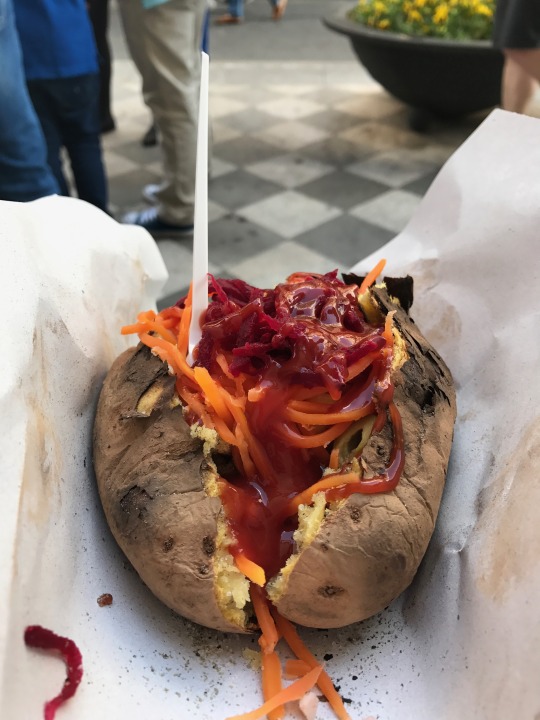
A huuuuge baked potato I got from a street vendor, stuffed with just about everything you could imagine: carrots, corn, cheese, pepper, and other ingredients I can’t recall now.
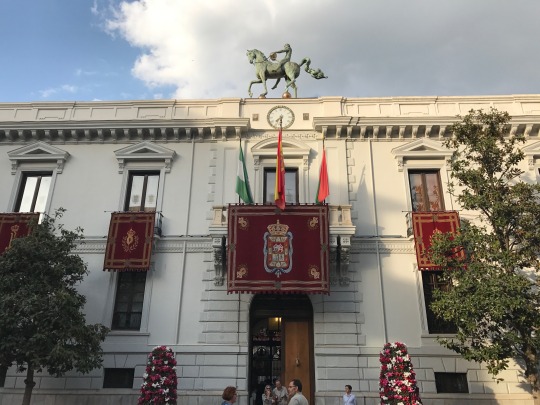
El Ayuntamiento (town hall) de Granada

Exploring the Albayzín (the little white village I saw from up above in the Alhambra earlier that morning).



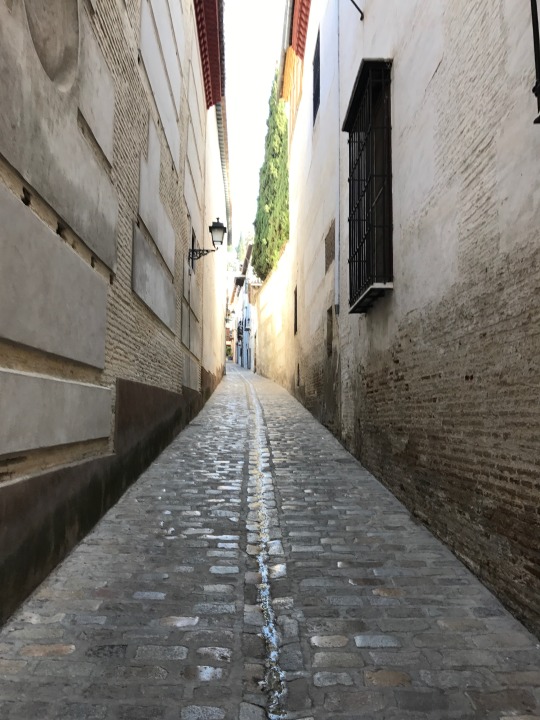

Mirador de San Nicolás, with a great view of the Alhambra.




2. SEVILLA

When I arrived at my AirBnB in Sevilla, I was greeted by traditional Andalusian tiling on the stairs and wall. It can be a little much at times, but I still think it’s so pretty!
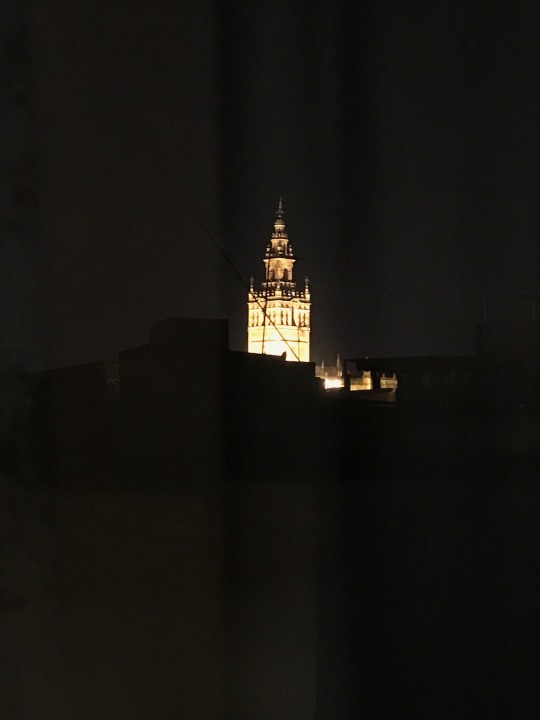
View from my AirBnB of la Giralda, the bell tower of the Seville Cathedral


Parque de María Luisa


Plaza de España. My pictures simply do not do this place justice. I got here and absolutely fell in love - the plaza is simply beautiful. The ambience is distinctly Spanish and is filled with different sounds: street flamenco dancers and their shoes on mini-tablaos, the clip-clop of horse drawn carriages, the music of street performers, the chatter of castañuelas... I could have stayed there for hours.
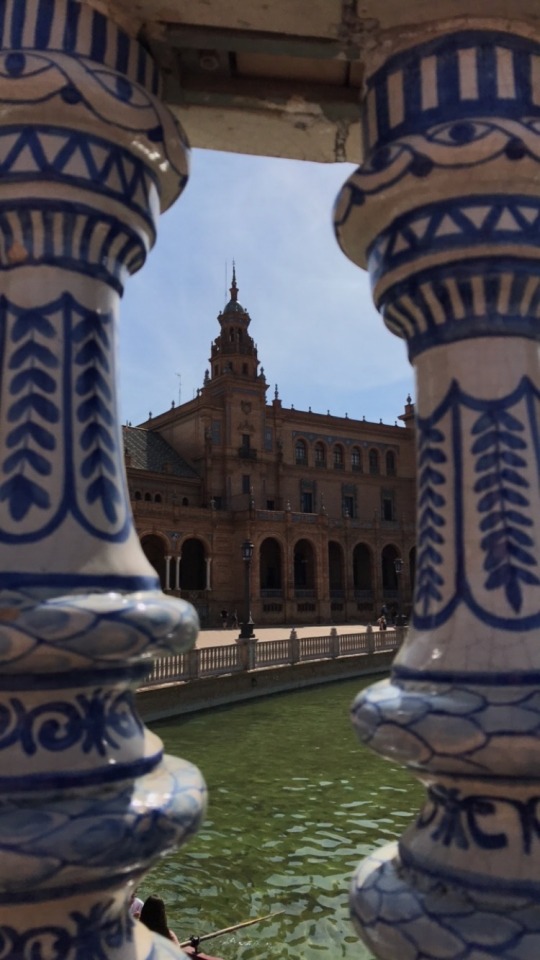


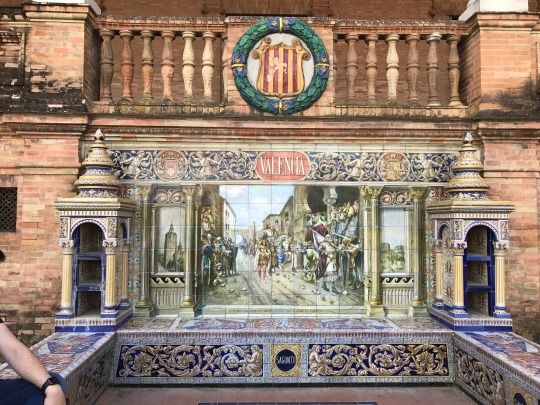
Every Spanish province has its own bench/monument in the plaza

I found some Valencians, and we took each other’s picture :)



The view from the rooftop of my AirBnB

Another Semana Santa procession, this time in Sevilla. You should be able to make out the cone hats a bit more clearly in this one
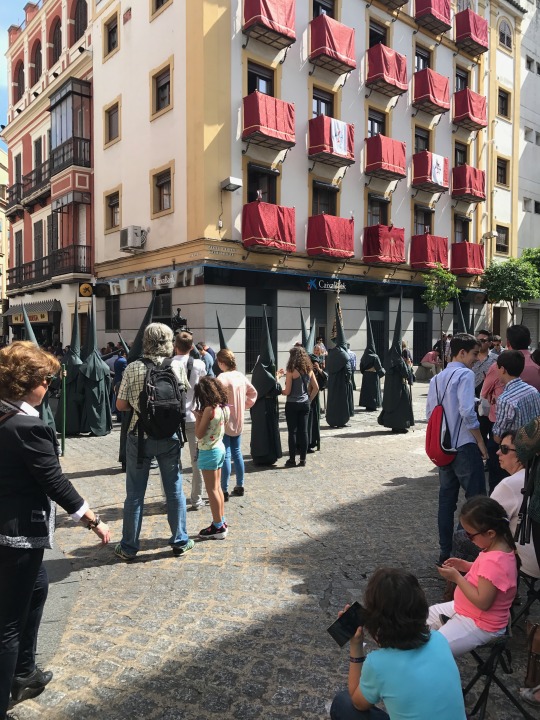
I learned that I had to be very flexible while navigating the streets of Sevilla. Not only were they a virtual labyrinth to begin with, many times I would finally find the right street to follow, only to be forced to turn around because it was blocked off by a procession. This trip was an exercise in patience and flexibility for me in many ways - in this case, instead of getting frustrated, I decided to just relax and enjoy the procession!


Another Virgin effigy



The Cathedral of Seville, the third largest cathedral in the world

El Real Alcázar de Sevilla (the Royal Palace of Seville)





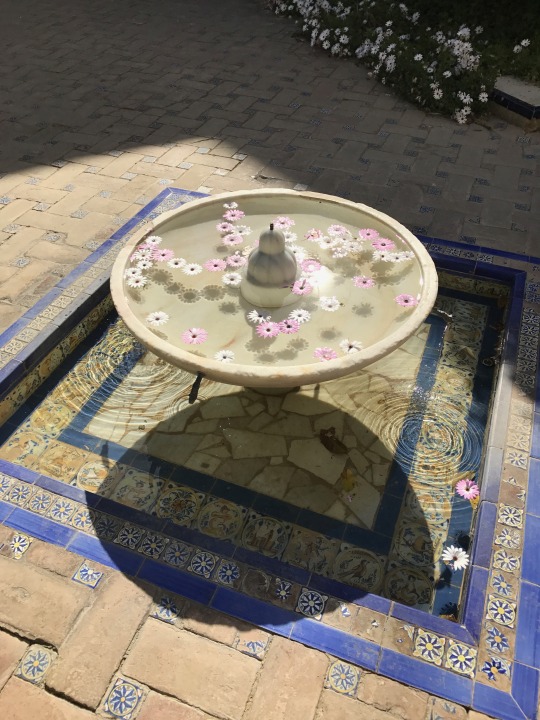





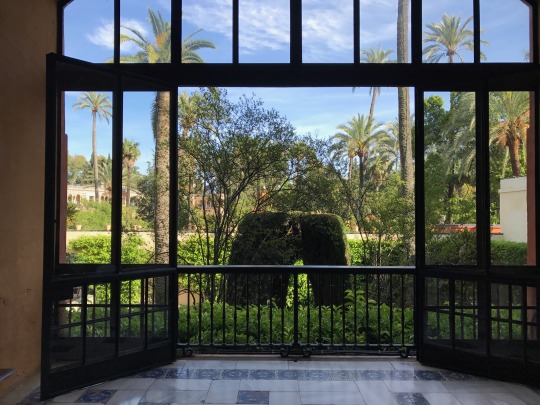



The palace gardens were gorgeous and very peaceful

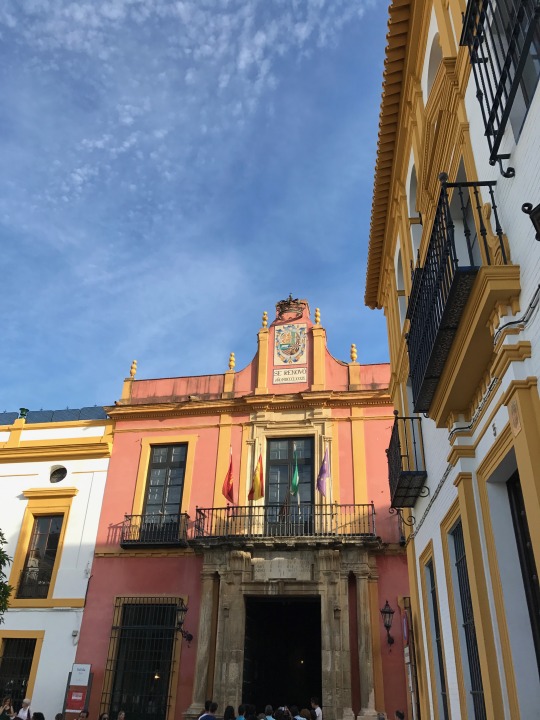


One of the processions either entering or leaving the cathedral (don’t quite remember which)
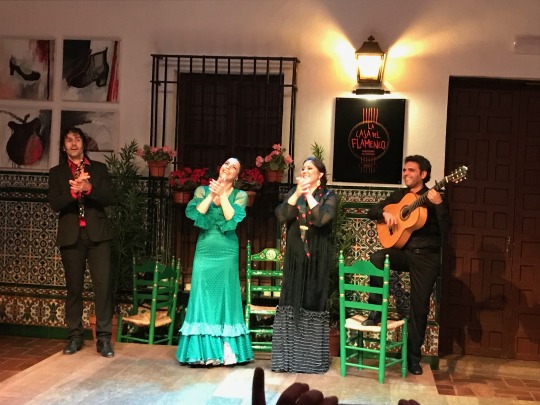
Flamenco Show. Unfortunately, there was no photography allowed until the very end. Although most spaniards would never really go out to see a flamenco show (it is almost solely a touristic attraction at this point), this show was performed in authentic style (or at least, that’s what the reviews on TripAdvisor told me!) and the dancers and musicians were very talented.

La Giralda at nighttime
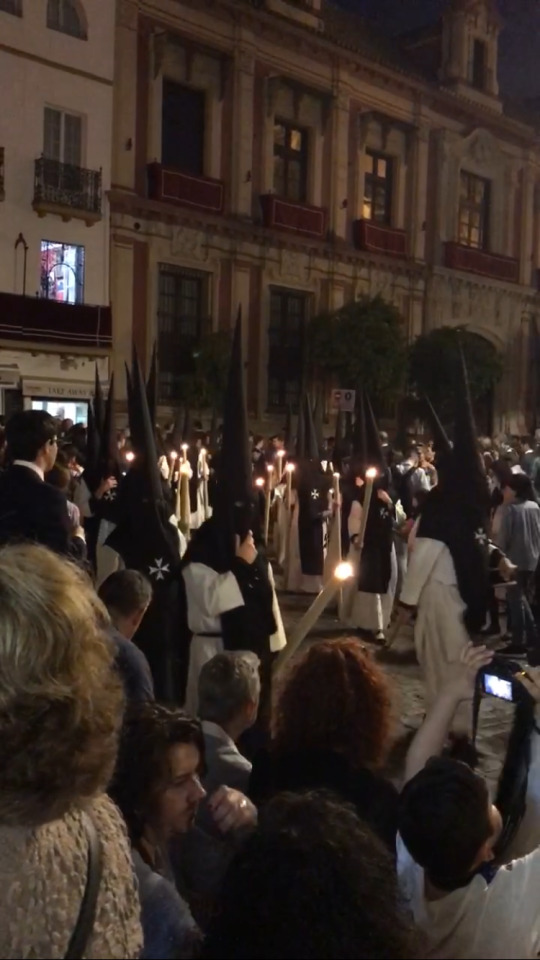
A procession the night before Easter.
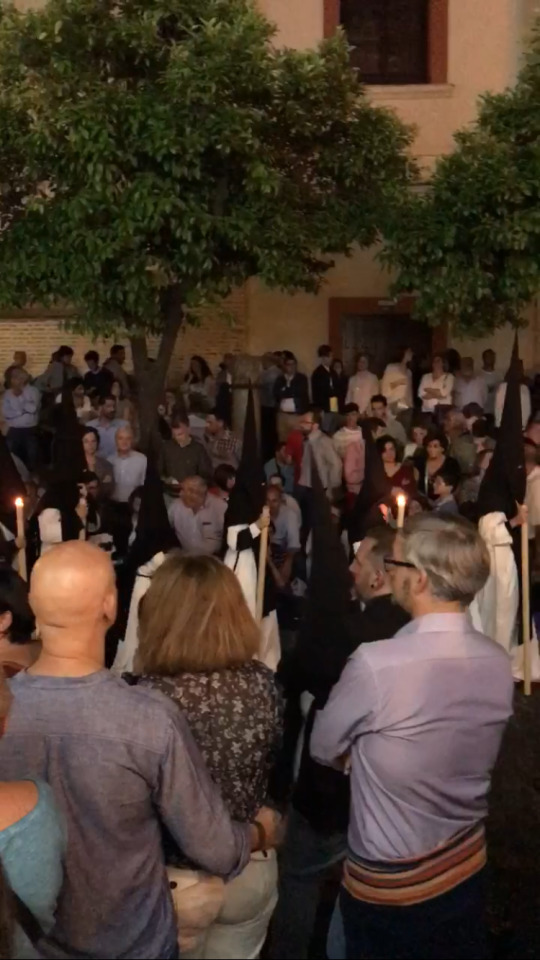

Pro tip - if you don’t want to have to pay to tour the cathedral, go to a service!


It’s pretty cool to say I went to Easter mass in the Catedral de Sevilla, the third-largest cathedral in the world!

A procession on Easter Sunday - notice the robes are white today instead of black, symbolizing purity but unfortunately looking even more like klansmen.
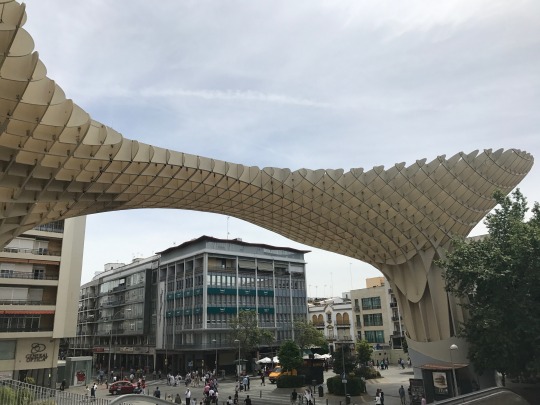
Metropol Parasol, an exposition center in Seville.


Ayuntamiento de Sevilla


La Maestranza, or la Plaza de Toros de Sevilla - The bullfighting ring of Seville

After having studied the culture behind bullfights year after year in Spanish classes, I finally got to see one for myself. Even though I had a feeling I wouldn’t like it, I decided I needed to witness a bullfight in order to form an educated opinion.

And... I hated it. I understand that bullfights are traditionally a way to honor the bull, but all I see is suffering and torture. The bull really has no options. If it is docile, it is prodded and goaded into attacking. If it is aggressive, it is tortured and then killed. What a way to spend Easter Sunday - paying to see the Lord’s creatures suffer unnecessarily :(



Although this bullfight had six bulls, I only got through three before I had to leave the stadium.


While I was waiting for my bus to Lisbon, they were filming a movie at the Seville bus station!
3. LISBON
The leg of my trip from Sevilla to Lisbon was by far the longest of my two-week journey, lasting around 8 hours total. I was horrified upon boarding my bus to observe that there was no bathroom located in the back, knowing full well that nothing short of a miracle would allow me to survive 8 hours without being able to use facilities. I did notice a few elderly couples on the bus as well, and figured they would crack before I did. I assumed that if the bus had no restroom, it would have to make rest stops at least every other hour, but 3 hours into the ride it had not stopped once. It wasn’t until a girl got up from her seat and disappeared behind me that I realized the bathroom on board was ingeniously built (disguised) into the side of the rear-exit stairs. Although this location forces you to more or less climb into the lavatory, I was quite relived to realize that there was indeed a bathroom on board. Who would have thought?!
On a more serious note, traveling to Lisbon by bus really helped me realize just how cool the European Union is. Because both Spain and Portugal are part of the Schengen Area, the free-movement zone of the EU, they have no border control. Driving into Portugal was as simple as driving from one state to another in the US. There’s just a “Bem vindo a Portugal” sign and that’s it - you’re in a new country! In fact, I totally forgot I had left Spain, and when the bus driver took a break at a rest stop (this rest stop finally came after I had discovered the on-board bathroom), I accidentally tried to order food in Spanish!
However, speaking Spanish is still of some value in Portugal. I found that if the person I was speaking to didn’t know English, I could still have a jumbled conversation with them if I asked a question in Spanish - I would just recieve a response in Portuguese. Although the two are absolutely separate languages, they share their similarities, and I was surprised at how much Portuguese I could vaguely understand given my knowledge of Spanish. Written Portuguese was even better. I found that when I concentrated too hard on deciphering Portuguese, I psyched myself out, but when I just did a calm skim over the text, I could get the general idea. This was very useful in a wide variety of scenarios, from understanding instructions from my AirBnB host to reading public transit maps.

Praça de Dom Pedro IV (Rocio)




From my observations, Lisbon seemed to rely much more on tram cars than on busses for public transportation.

Some of them were older while a few were more modern
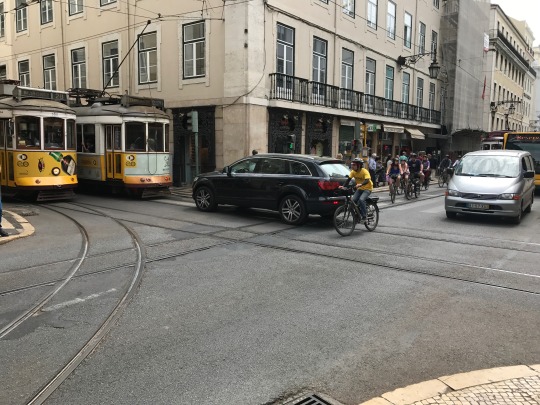
I just had to stop here and get some shots of the laughably difficult-to-navigate roads in center city Lisbon. Between cars, trams, busses, cyclists, and pedestrians, the roads are a mess.

Take this scene for example. A car is trying to go down a street that is completely blocked by two tram cars. This makes a further traffic jam because the car isn’t able to finish its turn, irritating cyclists, all while a pedestrian jaywalks in between the car and trams. Crazy huh?

Cais das Colunas.

Arco da Rua Augusta

Praça do Comércio
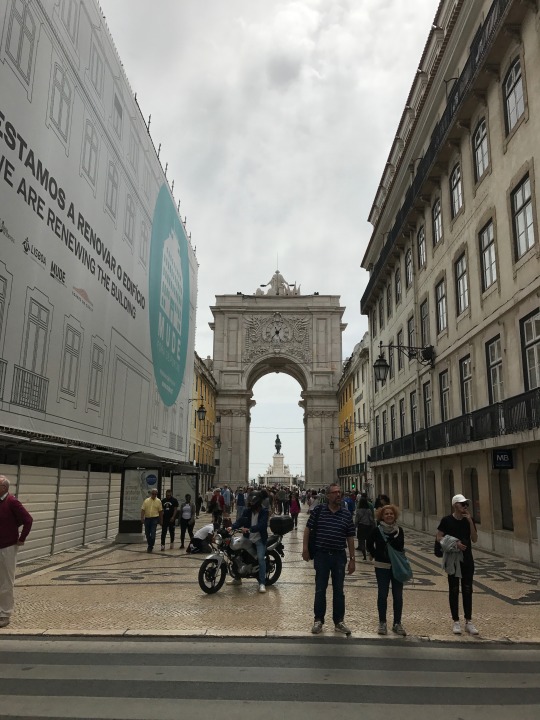
Next, I went on the Elevador da Glória - similar to the trams I mentioned earlier, except it scales a mini-mountain. The picture right below is what the elevador is supposed to look like...

but the next picture is what it actually looks like.
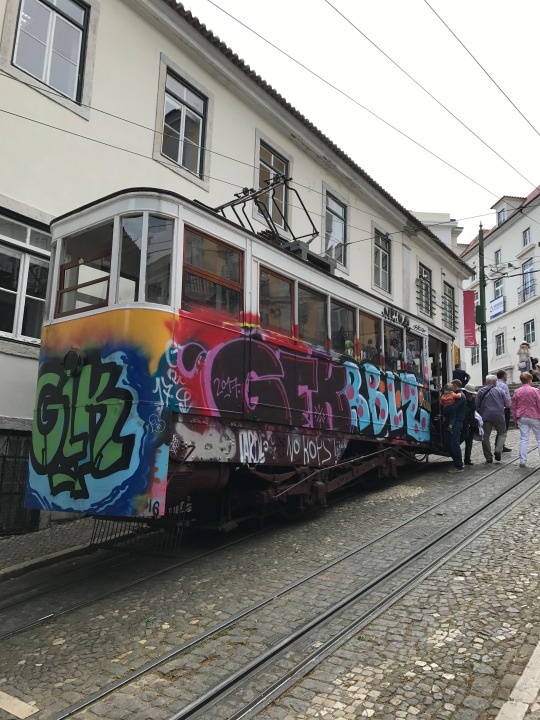
Thank you street artists!
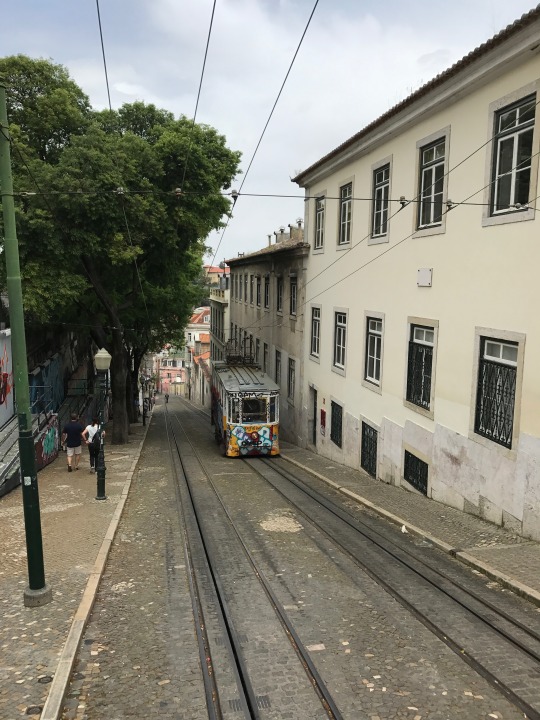

The ride was cool and all, but it was majorly overpriced and there wasn’t really anything at the top, so I was a little disappointed.

The street that my AirBnB was on - pretty jam packed with cars, but still pretty. I love all the different brightly colored buildings.

The craziness that is the Rua Augusta
Later that afternoon, I went to Belém (Bethlehem in English), a municipality of Lisbon that was by far my favorite part of my visit to Portugal. I didn’t take any pictures of it, but in order to visit the various monuments I walked through a beautiful park full of happy couples, children running around playing sports, and picnics in the grass. Oddly enough, passing by and enjoying the calm scene hit me with a wave of nostalgia for home - who would have thought a park in Portugal would make me yearn for an American summer?

Mosteiro dos Jerónimos, a beautiful monastery that I admired from the outside because I’m too cheap to pay the entrance fee for everything (and trust me, I had paid enough to enter various religious buildings by that point).
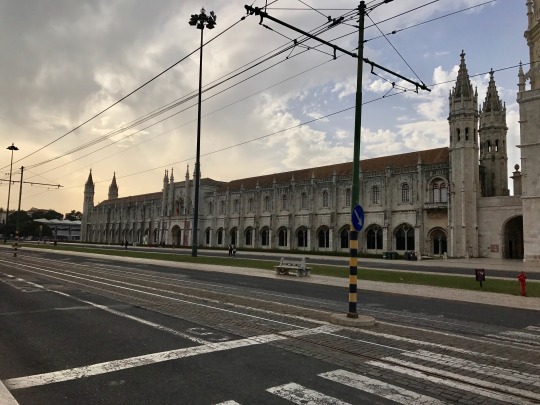





Padrão dos Descobrimentos




Lisbon trying to get that SanFran aesthetic?

Torre de Belém, beautiful at sunset

The next day, I took a short-distance train to Sintra, a famous national park on the outskirts of Lisbon.


Palácio Nacional de Sintra


To walk to the Moorish Castle, I had to hike through some of the forests of Sintra. The pictures truly don’t do the walk justice. On family vacations, I’m normally the one who complains about hiking, but this hike had even me blown away by its natural beauty and great look-out points.
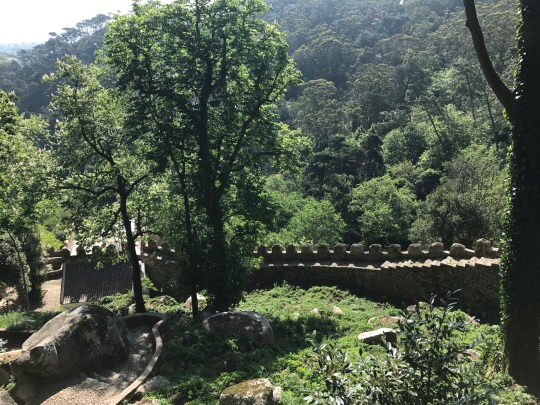



If you look closely, you can see the Moorish Castle (Castelo dos Mouros) on the mountain in the distance. However, I couldn’t hike all the way up to see it, because there was a steep entrance fee and I’m a cheapskate.

The Palácio da Pena. Get ready for a ton of pictures of this one... I just couldn’t help myself. To me, the architecture is absolutely stunning and very original. For this one, I did cave and pay to go inside.





Like... is that incredible or what?!

Look closely to see the village houses out in the distance




If you look closely, you can see the Moorish Castle on top of the mountain.

What is a trip through Europe without unflattering selfies??

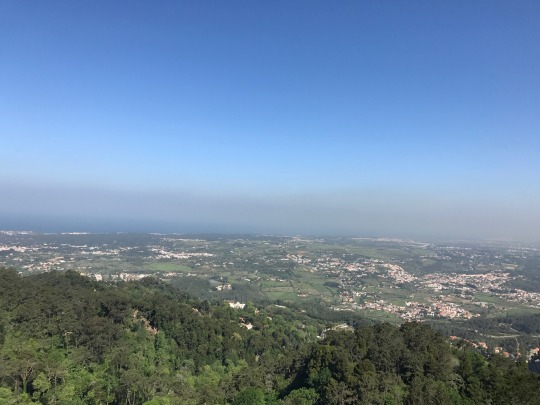


(See look I told you, I actually paid to go inside this once!)
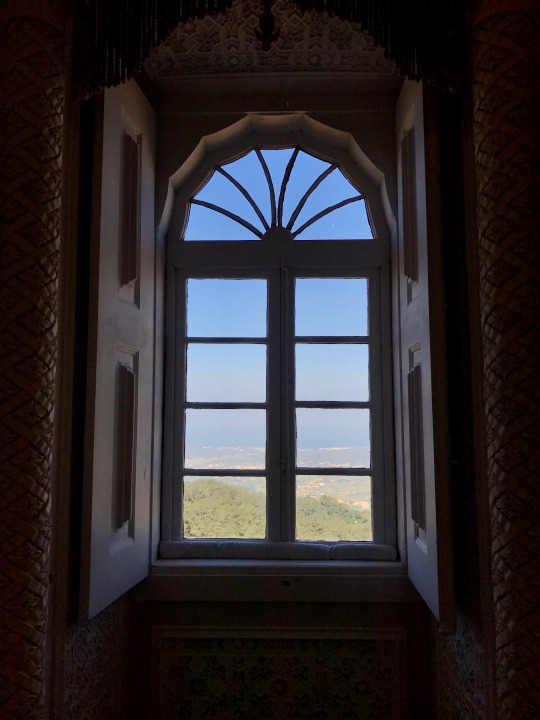




After visiting Sintra, I took the train back to center city Lisbon to explore until I had to leave for my flight to Bilbao

Back in center Lisbon near the Praça de Dom Pedro IV. On top of the hill you can faintly make out the Castelo de São Jorge, where I took these next few pictures
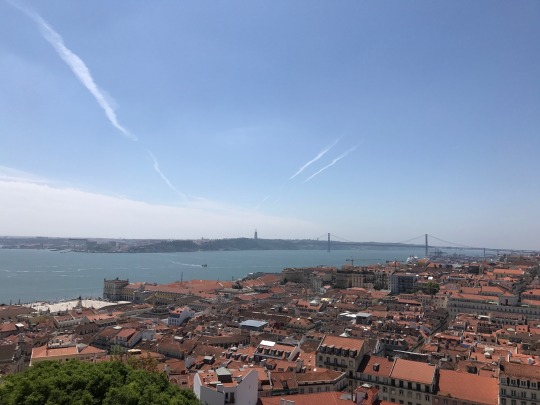
The view at the top was magnificent - shame there was no Elevador da Glória to make this (significantly more challenging) ascent






The walk down was great!

The walk back up, not so much...

Igreja de São Vicente de Fora

For my flight to Bilbao, I was very frustrated that the online check-in did not work for me for some reason. I figured this was because I had purchased the flight off a semi-sketchy third-party website with a great deal on tickets. Knowing this, I got to the airport extra early to get in line and check in the old-fashioned way, intentionally leaving plenty of wiggle room even for an international flight just in case there were any problems with my ticket. Little did I know I would have the most incredible luck when I got to the airport.
First, as I was stopping to get something out of my backpack, a sweet random woman came up to me and asked if I would like some chocolates. Her suitcase was overweight and she was trying to get rid of things. Not too bad huh?
The nice happiness-boost from the chocolate lady wore off pretty quickly when I saw the check in line. It was colossal (the airport was busier than normal because of the Easter season) and moving slowly. I tried to check in on my phone and on the digital machines one last time, but still no luck - each time I would just get a message saying I had to go talk with customer service, so I grudgingly joined the humongous line.
I had barely been in line for 5 minutes, however, when a very kind airline employee came up and asked me what I was waiting in line for. Evidently, because there were so many people waiting to talk to customer service and he just happened to not be busy, he was working from the back of the line up to see if he could help customers and reduce the line. I explained that I just needed to check in for my flight, and he asked me to follow him. He accompanied me to another station where he allowed me to completely cut the line, after which he promptly checked me in and printed my boarding passes. He told me that I had actually purchased budget tickets that didn’t include a checked bag (thanks sketchy third-party website), and that I would normally have to go back to customer service to pay to check my suitcase. However, because the customer service line was already way out of hand, he said he would just go against company policy and check my bag for free. I was completely flabbergasted and could not believe my luck. I thanked him profusely as he hurried away to assist another customer. I honestly felt undeserving of such a stroke of good fortune - I had arrived at the airport with time to spare, and surely there was someone in more of a rush who could have used that godsend more than I could have. Either way, I just had to give that mysterious TAP Airlines employee a shoutout - you the real MVP man.
4. BILBAO
I really enjoyed my time in Bilbao. I happened to visit during the week they were doing a sort of “piano project,” where a number of pianos were placed in public spots and anyone could just walk up and play them. I was lucky enough to come across at least four while exploring the city!
Another neat thing about Bilbao (and Basque Country) in general is their language, Basque or Euskera. Words in Basque can be pretty intimidating to pronounce, to say the least. I didn’t think to snap any pictures at the time, but the picture below I found on Google of a street sign gives you a bit of an idea. Thankfully, everyone (or mostly everyone) also speaks Spanish, so I didn’t really run into any trouble.


I think the snapchat caption just about says it all. My AirBnB hosts had to get up early the next morning for work and I had already arrived a bit later than anticipated, and I didn’t want to irritate them even further by waking them up at such an ungodly hour - so I just sucked it up and waited until morning.

Churros and cola-cao, a delicious breakfast (even if it is pretty meager)

Parque de Doña Casilda Iturrizar

El Cachorro (the puppy), a sculpture made of flowers that’s supposed to look like a west highland white terrier. Unfortunately, the flowers were not quite in bloom yet.

The Guggenheim Museum

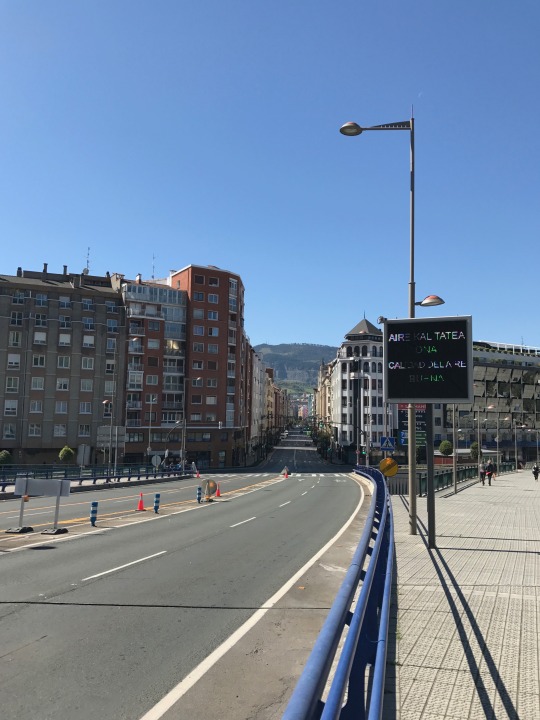

Ayuntamiento de Bilbao
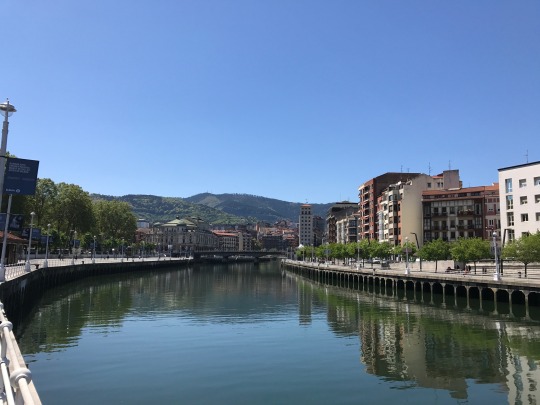
Río Nervión

El Casco Viejo

Catedral de Santiago de Bilbao

Iglesia de San Nicolás

La Alhóndiga. This is a cool one - it’s a multipurpose building in center city Bilbao to serve various needs for city residents. Among other things, it has restaurants, shops, a library, a gym, a movie theater, and an auditorium.
5. SAN SEBASTIÁN
San Sebastián is a very popular beach town to the east of Bilbao. It’s actually quite close to the border with France, and I heard just about as much French spoken while visiting as I did Spanish. Although the water was too cold to swim in and the wind made even laying on the beach a bit chilly for my taste, the city was absolutely beautiful.
To get from Bilbao to San Sebastián was only about an hour ride by bus. When I purchased bus tickets online, I wasn’t really paying too much attention to the type of bus, and €15 seemed a reasonable price to me so I didn’t think anything was out of the usual. However, I was blown away when I saw a sleek black bus that said “ALSA Premium” on it pull up to the station and realized it was for me. This bus was by far the fanciest I’ve ever been on. I mean, it had a flight attendant. On a bus. What? Did I mention complimentary snacks and beverage service? I sure wish I had this bus for my 8 hour ride from Seville to Lisbon! I was almost sad when the ride ended. I found a picture of the bus model online so you can get a better idea.


The Río Urumea, that flows through the city of San Sebastián and into the Bay of Biscay.

El Ayuntamiento de San Sebastián


Playa la Concha



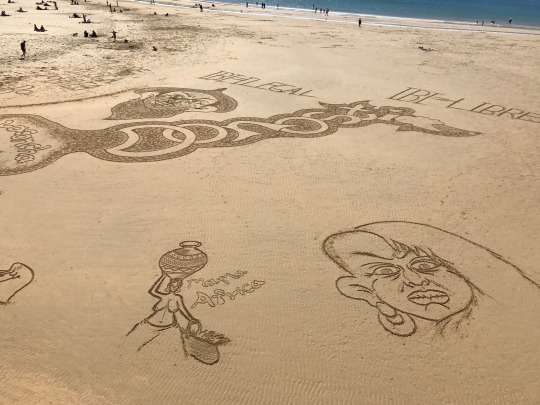
Such amazing artistry - a man down on the beach was drawing all these designs in the sand, and passerby on the bridge where this photo was taken would throw money down for him.




Catedral del Buen Pastor de San Sebastián



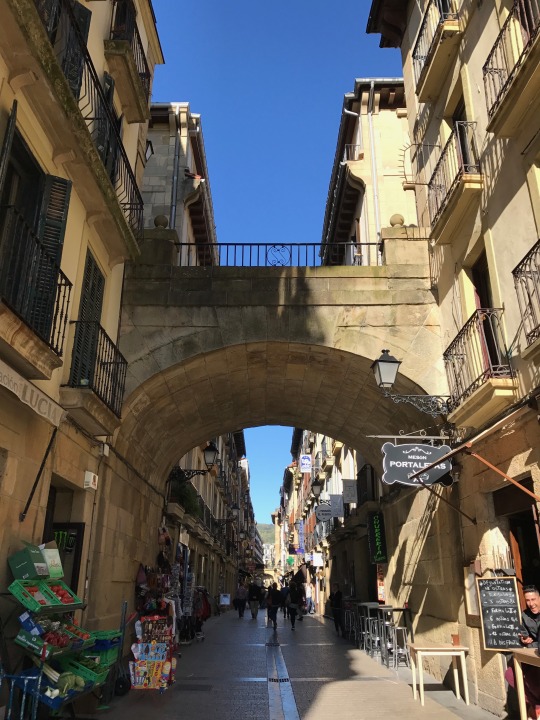

Basílica de Santa María del Coro

Iglesia San Vicente

6. MADRID
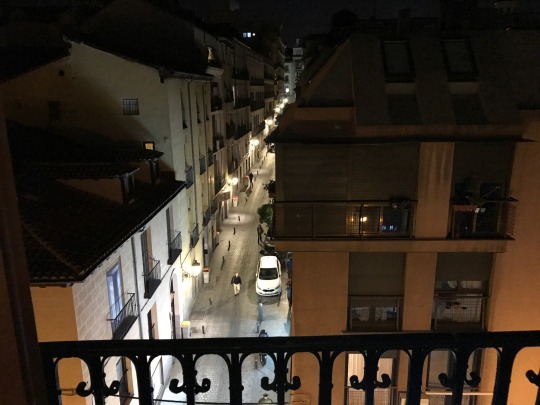
For the end of my two week traveling spree, I decided to splurge and treat myself a bit by booking a private single room in the cheapest hostel I could find in Madrid, instead of staying in a room in someone else’s house via AirBnb. This was the view from my balcony!

Because Madrid is the most globalized city in Spain, I was overjoyed to find a place where I could get a real, hearty American breakfast (breakfast in Spain is very, very light fare). It was so delicious (or maybe I had just missed real breakfast so much) that I ended up coming back here for breakfast again!

San Jerónimo el Real


Real Jardín Botánico





“I heard it and I forgot / I saw it and I understood / I did it and I learned.”
-Confucius

Parque de El Retiro

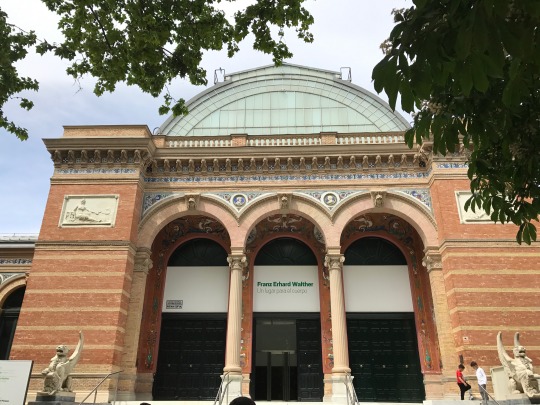



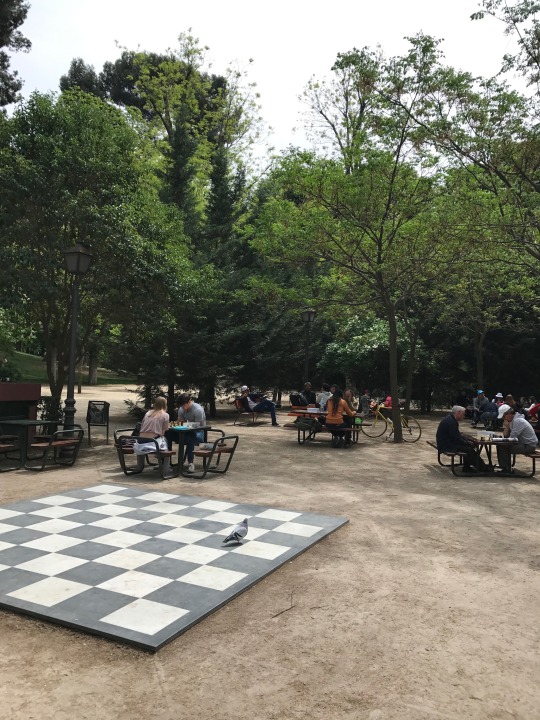
Cool spot in the park where you could rent a game of chess!

Puerta de Alcalá

Plaza de Cibeles. This building serves as the town hall of Madrid. Notice the “Refugees Welcome” banner - wishing our president could take a page out of Spain’s book.

Edificio Metrópolis along the Gran Vía

Estatua del Oso y el Madroño. This statue represents the Coat of Arms of Madrid and is also the 0 kilometer mark for all roads in Spain.

Estatua de Carlos III de España in the Puerta del Sol, the Spanish equivalent of Times Square.




Plaza Mayor

Estatua de Felipe III de España
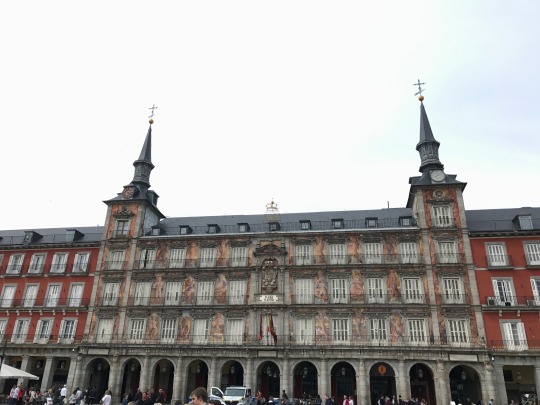





Real Basilica de San Francisco el Grande

Palacio Real de Madrid (Royal Palace of Madrid) seen from a distance.

More pictures of the Palacio Real




Templo de Debod, a temple that was disassembled in Egypt and reassembled in Madrid, now located alongside a nice public park.


Biblioteca Nacional, the Spanish National Library

It’s really cool to me that Spain has a ministry (government department) of equality.

A protest by Venezuelan expats living in Spain, decrying political corruption in Venezuela and trying to raise awareness of their country’s economic crisis.
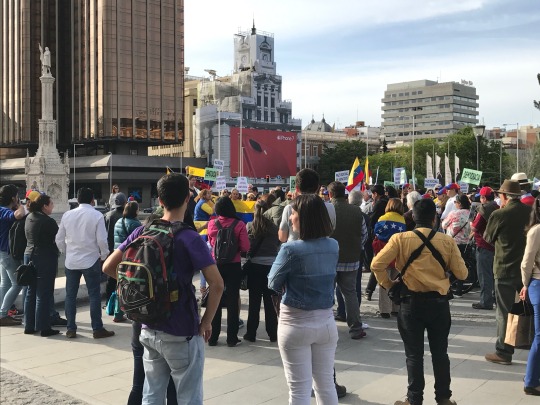

Las Bicicletas son para el verano (Bicycles are for Summer), a play I read for my Spanish Literature & Cinema class during the semester. I had the chance to see the play live in Madrid!
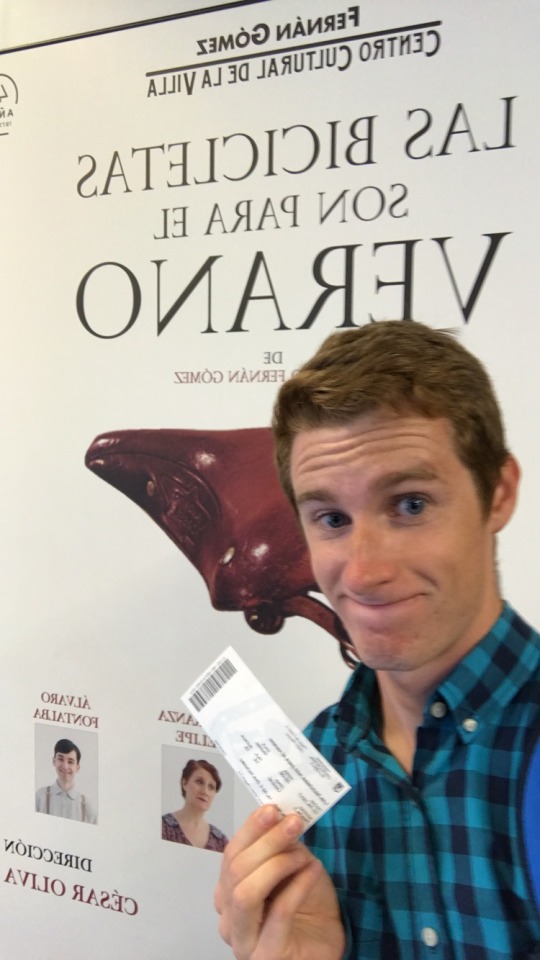

I was always taught it’s good to arrive to the theater a half-hour early, but here, the other spectators were living up to the stereotypes about Spanish punctuality.

Madrid at nighttime

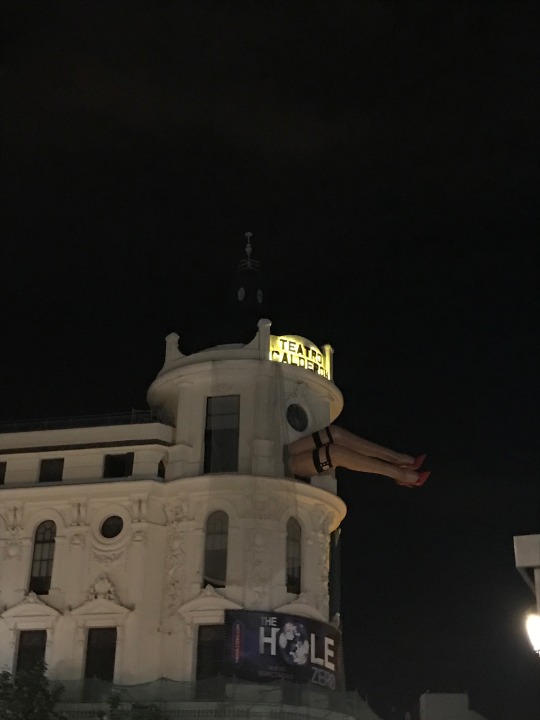
7. TOLEDO
The last stop on my two-week adventure was Toledo, Spain. The city had a very distinct charm and some absolutely incredible views of mountains and valleys.

I was already impressed with Toledo as soon as I stepped off the train - look at how how pretty the train station is!

Puente de Alcántara




El Alcázar de Toledo






Catedral de Santa María de Toledo






Inside Monasterio de San Juan de los Reyes


Puerta de Bisagra
At this point, I took a very, veeeery roundabout hike (I didn’t really know what I was doing, I was just looking at the maps app on my phone) to try to find the Mirador del Valle, a lookout spot where you can see the whole city of Toledo in all its glory. It was a very hot, sweaty hike, but I finally made it, and the views were totally worth it.





I also found another mini-mountain next to the lookout spot where I could get an even better vantage point of the city, so of course, I climbed it.
If you’ve reached this point in the post, you can smile as wide as I am in that last pic... you’re done! The never-ending blog post is finished. If you actually read all this, you deserve some award.
Although I was sad that my journey finally had to come to an end, upon my return to Valencia was greeted by my wonderful host mom, who stayed up until midnight to make sure I was well-received with a hot home-cooked meal (she’s the best).
This trip was very eye-opening for me in a lot of ways. It was an exercise in maturity to live independently for two weeks, not to mention the absolutely incredible opportunity to see so much of Spain in so little time. Even so, there are many more places I would have liked to visit. I’m already starting my list for round two. Spain, you haven’t seen the last of me!
0 notes